-
What are specific limitations and artifacts that HSC users should be aware of?
NOTE: Unless otherwise noted, the graphics in this section are taken from version 1.
The Hubble Source Catalog is composed of visit-based,
general-purpose source lists from the Hubble Legacy Archive (hla.stsci.edu) .
While the catalog may be sufficient to accomplish the science
goals for many projects, in other cases astronomers may need to make
their own catalogs to achieve the optimal performance that is possible
with the data (e.g., to go deeper). In addition, the Hubble observations
are inherently different than large-field surveys such as SDSS, due to
the pointed, small field-of-view nature of the observations, and the
wide range of instruments, filters, and detectors. Here are some of the
primary limitations that users should keep in mind when using the HSC
.
LIMITATIONS:
Uniformity:
Coverage can be very non-uniform (unlike
surveys like SDSS), since a wide range of HST instruments,
filters, and exposure times have been combined.
We recommend that users pan out to see the full HSC field when
using the Interactive Display in order
to have a better feel for the uniformity of a particular dataset.
Adjusting
the value of NumImages used for the search can improve the uniformity in many cases.
See image below for an example.
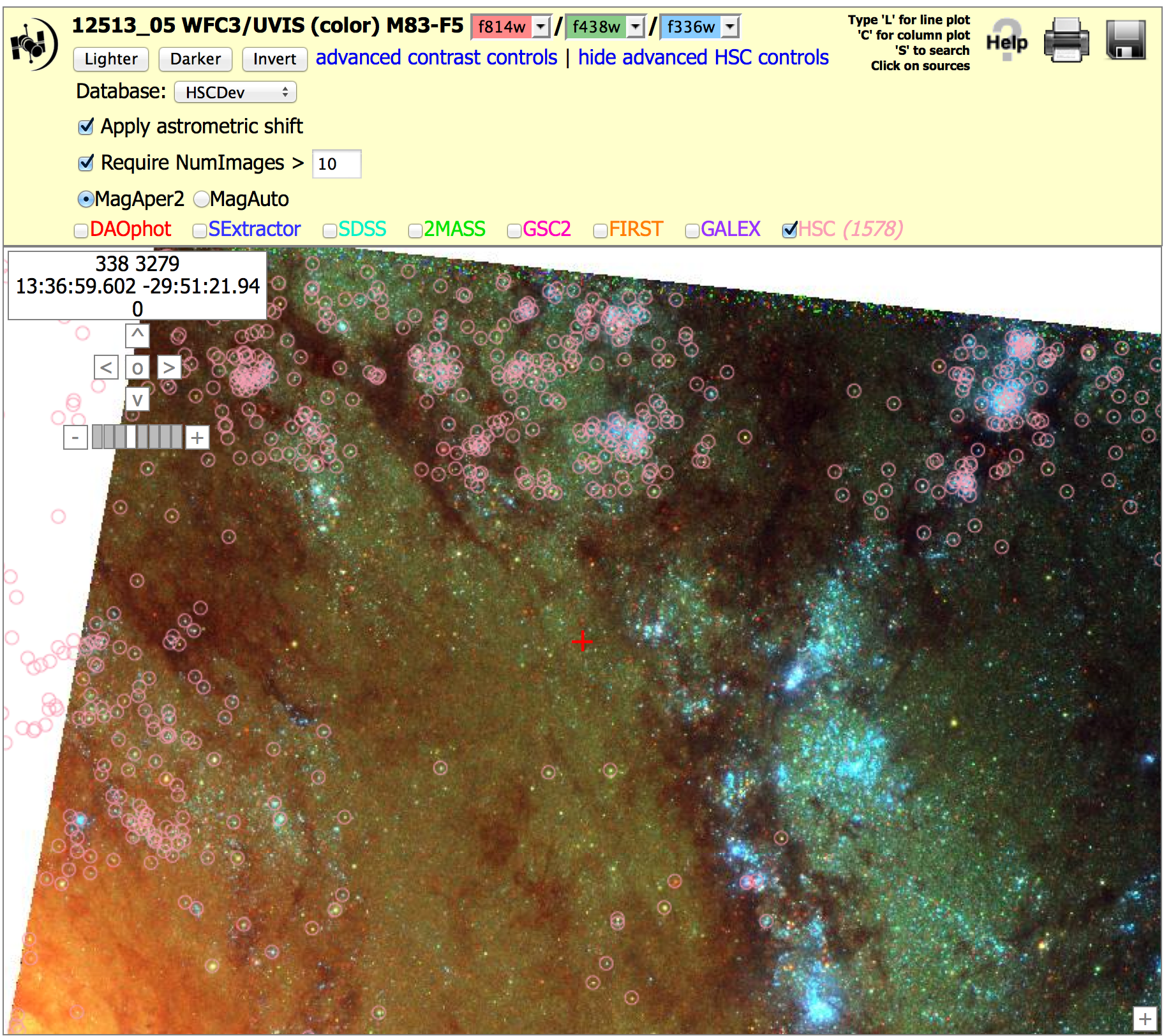
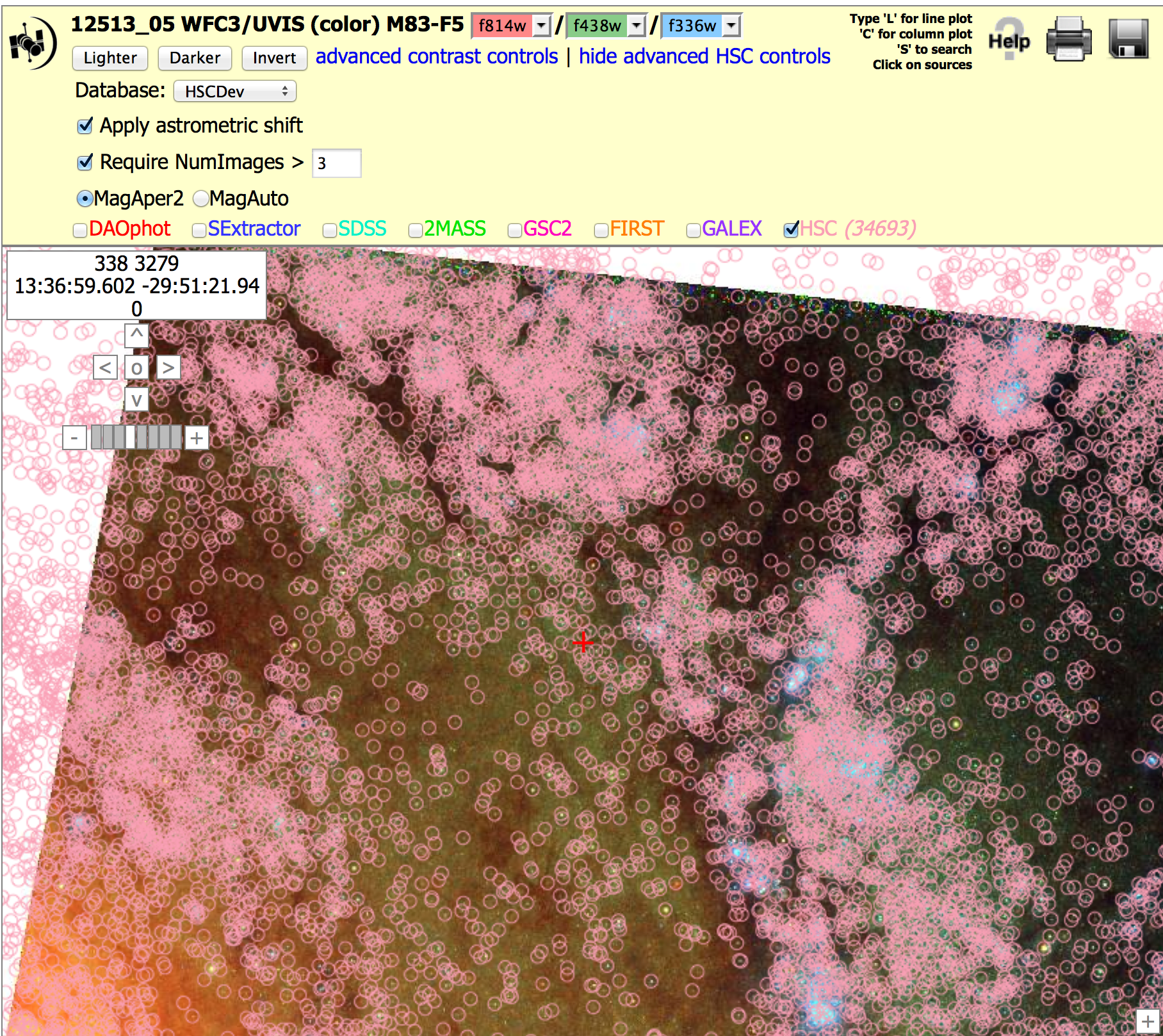
Astrometric Uniformity:
In version 2, about 91% of HSC images have coverage in Pan-STARRS, SDSS, or 2MASS that
permits absolute astrometric corrections of the images
(i.e., AbsCor = Y) to a level of roughly 0.1 arcsec.
See (Whitmore
et al. 2016) for more details about astrometry, and to see the
corresponding map for version 1. We note that in version 2 we changed
the algorithm to use all three datasets, weighted by their goodness of
fit. For the figure we show only the dataset with the best-fit
value. This tends to weight SDSS more heavily than in version 1 .
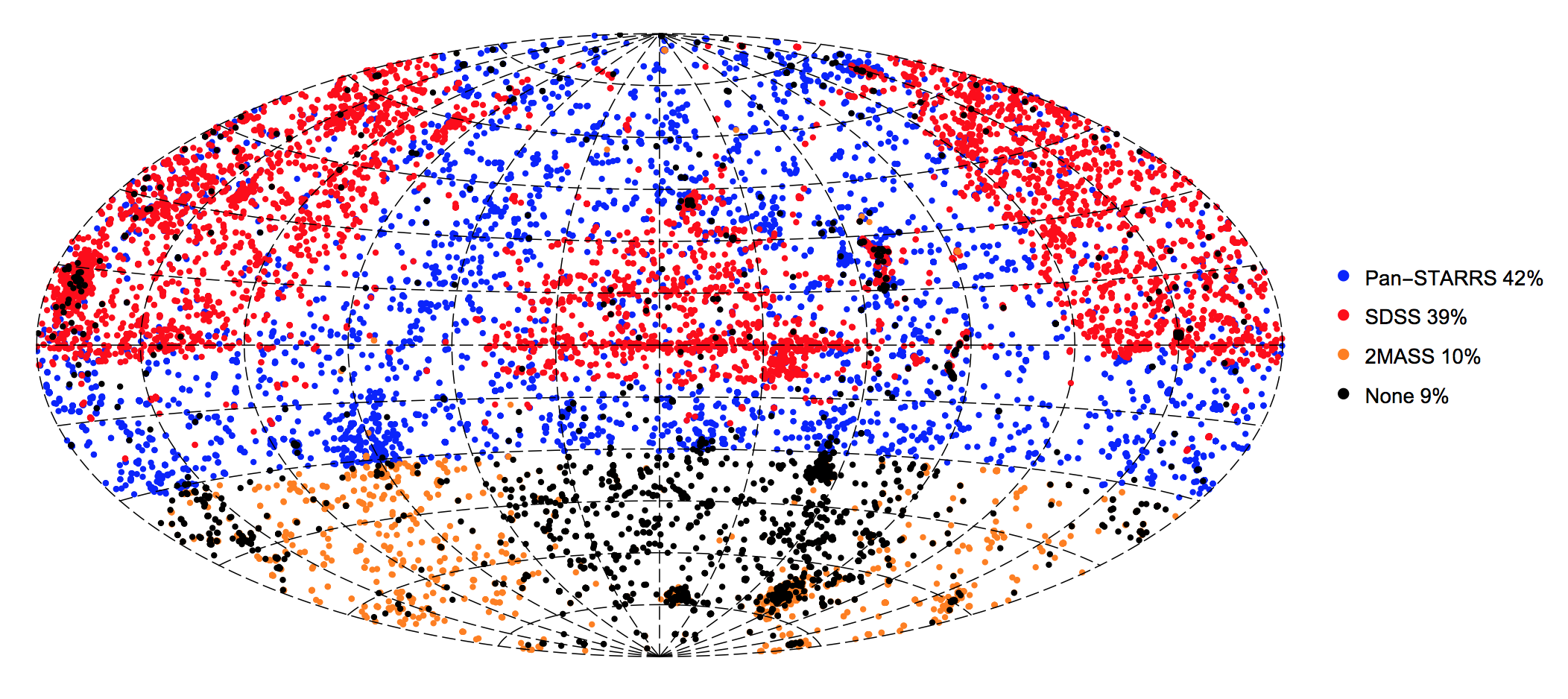
Depth:
The HSC does not go as deep as it is possible to go.
This is due to a number of different reasons, ranging from using an
early version of the WFPC2 catalogs (see "Five things you should know about the HSC" ), to the
use of visit-based source lists rather than a deep mosaic
image where a large number of images have been added together.
Completeness:
The current generation of HLA WFPC2
Source Extractor source lists have problems finding
sources in regions with high background.
The ACS and WFC3 sources lists are
much better in this regard.
The next generation of WFPC2
sources lists will use the improved ACS and WFC3
algorithms, and will be incorporated into the HSC in the future.
Visit-based Source Lists:
The use of visit-based, rather than deeper
mosaic-based source lists, introduces a number of limitations. In
particular,
much fainter completeness limits, as discussed
in Use Case # 1. Another important limitation imposed by this approach
is that different source lists are created for each visit, hence a
single, unique source list is not used. A more efficient method
would be to build a single, very deep mosaic with all existing HST
observations, and obtain a source list from this image. Measurements at
each of these positions would then be made for all of the separate
observations (i.e., "forced photometry"). This approach will be
incorporated into the HSC in the future.
ARTIFACTS:
False Detections:
Uncorrected cosmic rays are a common cause of blank sources.
Such artifacts can be removed by requiring that the detection be based on more than one image.
This constraint can be enforced by requiring NumImage > 1.
Another common cause of "false detections" is the attempt by
the detection software to find large, diffuse sources.
In some cases this is due to
the algorithm being too aggressive when looking for these objects
and finding noise. In other cases the objects are real,
but not obvious unless observed with the right
contrast stretch and
field-of-view.
It is not easy to filter out these
potential artifacts without loosing real objects. One
technique users might try is to use a size criteria (e.g.,
concentration index = CI) to distinguish real vs. false
sources.
Doubling:
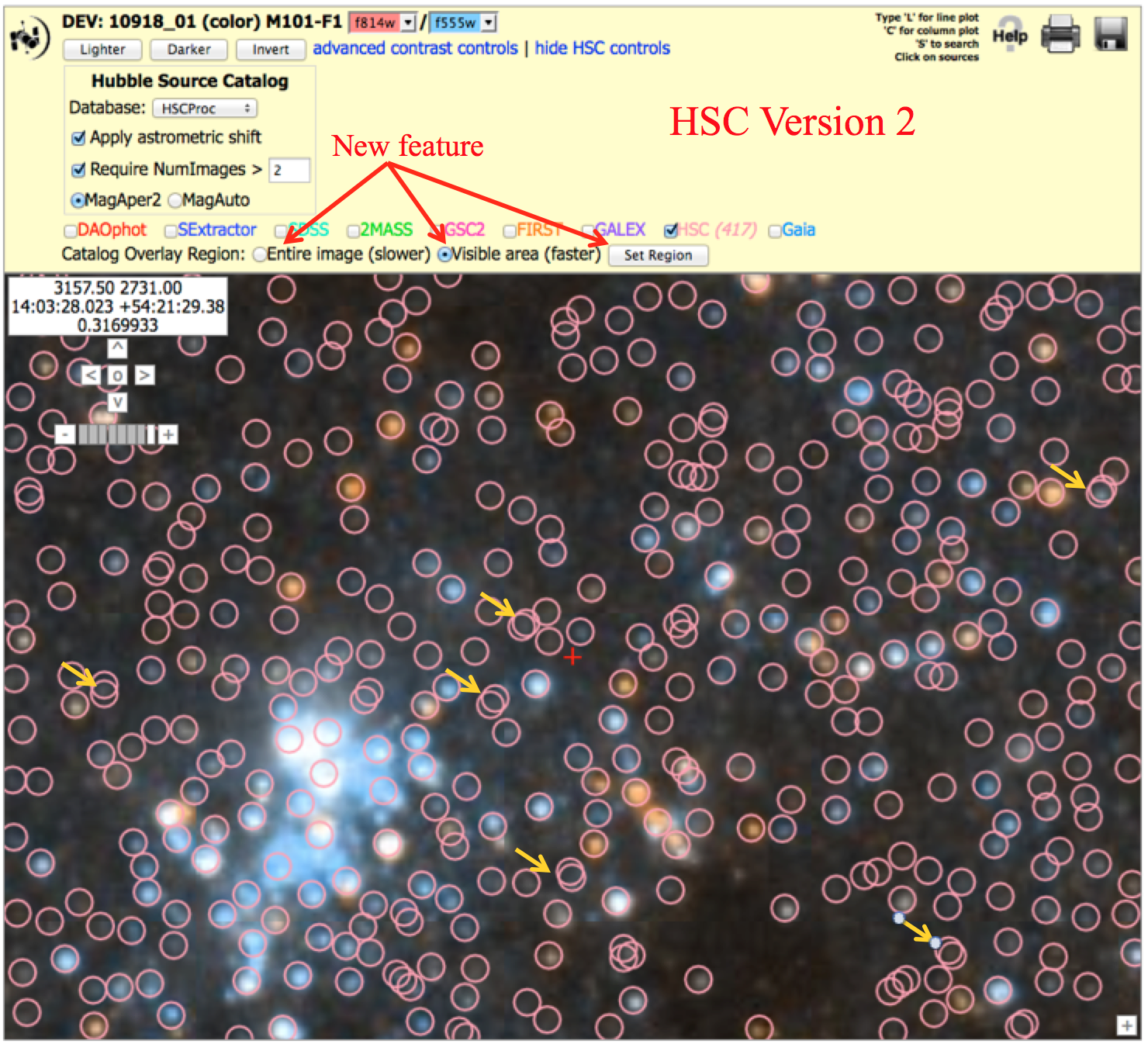 There are occasionally
cases where not all the detections of the same
source are matched together into a single
objects. In these cases, more than one match
ID is assigned to the object, and two pink
circles are generally seen at the highest
magnification in the display, as shown by the
yellow arrows in the example. Most of
these are very faint objects, and the primary
reason there are more in version 2 compared to
version 1 is the deeper ACS source lists.
There are occasionally
cases where not all the detections of the same
source are matched together into a single
objects. In these cases, more than one match
ID is assigned to the object, and two pink
circles are generally seen at the highest
magnification in the display, as shown by the
yellow arrows in the example. Most of
these are very faint objects, and the primary
reason there are more in version 2 compared to
version 1 is the deeper ACS source lists.
These "double objects" generally have very different numbers of images associated with the two circles. Hence, this problem can often be handled by using the appropriate value of NumImages to filter out one of the two circles. For example, using Numimages > 9 for this field removes essentially all of the doubling artifacts, at the expense of loosing the faintest 25 % of the objects (see figure on right )
Mismatched Sources:
The HSC matching algorithm uses a
friends-of-friends algorithm, together with a Bayesian method to break
up long chains (see Budavari &
Lubow 2012)
to match detections from different images. In some cases the
algorithm has been too aggressive and two very close, but physically
separate objects, have been matched together. This is rare, however.
Bad Images:
Images taken
when Hubble has lost lock on guide stars (generally after an
earth occultation) are the primary cause of bad images. We
attempt to remove these images from the HLA, but
occasionally a bad image is missed and a corresponding bad
source list is generated. A document showing these and other examples of
potential bad images can be found at HLA Images FAQ.
If you come across what you believe
is a bad image please inform us at archive@stsci.edu

-
Is there a summary of known image anomalies?
Yes - HLA Images FAQ.
Here is a figure from the document showing a variety of artifacts associated with very bright objects.
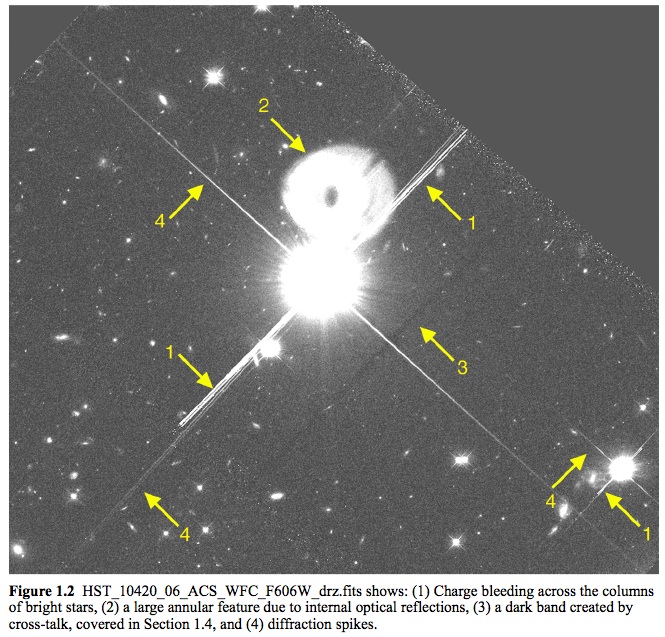
-
How good is the photometry for the HSC?
NOTE: This section is based on version 1 of the HSC, and more specifically, the studies performed for the (Whitmore et al. 2016) paper. Similar ongoing analysis of the version 2 database will be added to this section in the future.
Due to the diversity of the Hubble data, this is a hard
question to answer. We have taken a three-pronged approach to address it.
We first examine a few specific datasets, comparing magnitudes
directly for repeat measurements. The second approach is to
compare repeat measurements in the full database. While this provides
a better representation of the entire dataset, it can also be
misleading since the tails of the distributions are generally caused
by a small number of bad images and bad source lists. The third
approach is to produce a few well-known astronomical figures (e.g.,
color-magnitude diagram for the outer disk of M31 from Brown et al
2009) based on HSC data, and compare them with the original
study.
For our first case we examine the repeat measurements in the globular
cluster M4. For this study, as well as the next two, we use MagAper2 values (i.e., aperture magnitudes),
which are the default
for the HSC. In the last
example (extended galaxies) we use MagAuto values.
The figure shows that in general there is a good
one-to-one agreement for repeat measurements using different
instruments with similar filters. Starting with the best case,
A-F814W vs W3-F814W shows excellent results, with a slope near unity,
values of RMS around 0.04 magnitudes, and essentially no outliers.
However, an examination of the W2-F814W vs. W3-F814W and A-F814W vs
W2-F814W comparisons show that there is an issue with a small fraction
of the WFPC2 data. The short curved lines deviating from the 1-to-1
relation show evidence of the inclusion of a relatively small number
of slightly saturated star measurements (i.e., roughly 5 % of the
data).
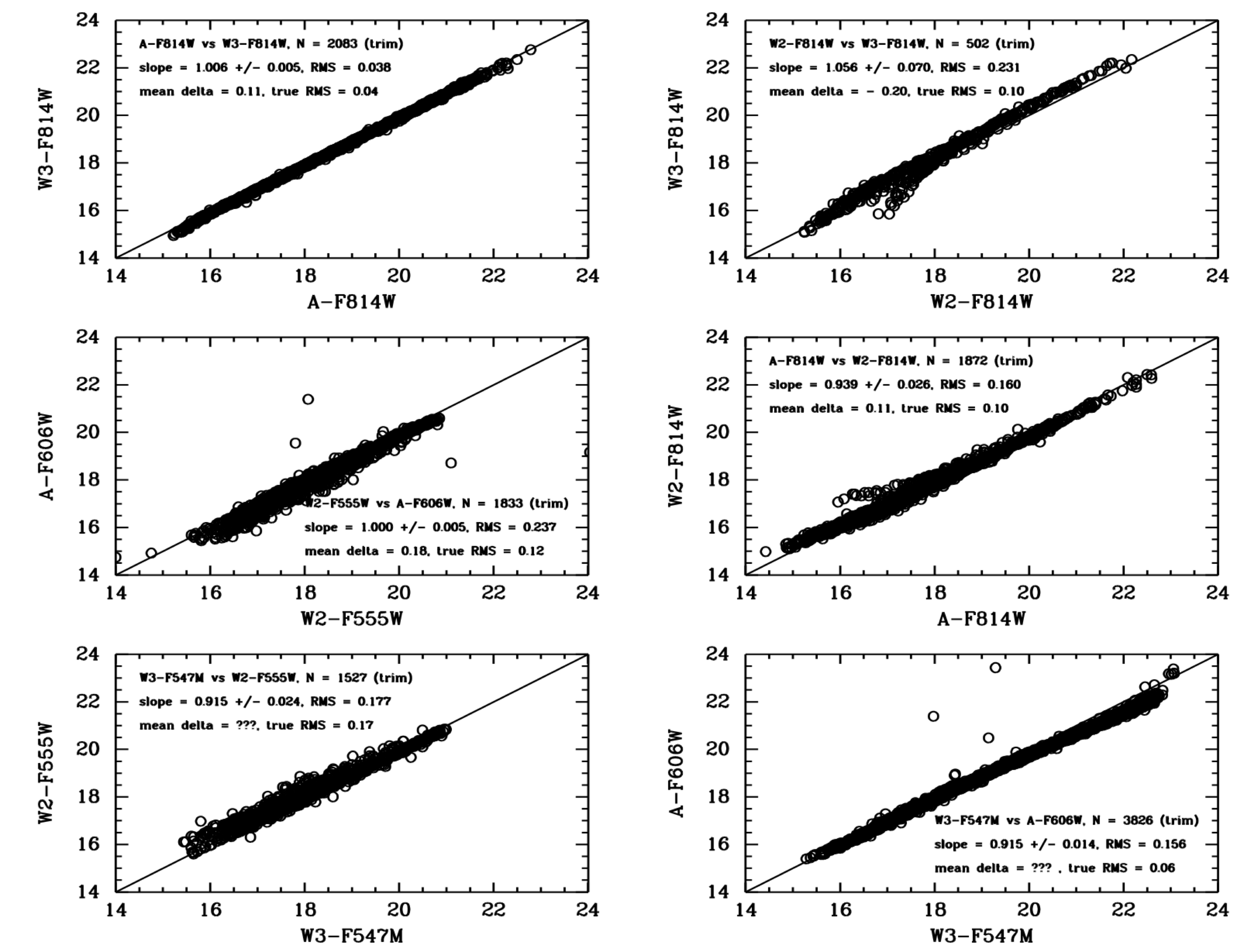
We now turn to our second approach; looking at repeat measurements
for the entire HSC database. The following figures shows the
distribution of comparisons between independent photometric
measurements of pairs of sources that belong to the same match and
have the same filter in the HSC for Version 1 and Version 2. The x-axis is the
flux difference ratio defined as
abs(flux1-flux2)/max(flux1,flux2). The y-axis is the number of sources
per bin (whose size is a flux difference ratio of 0.0025) that is
normalized to unity at a flux difference of zero.
The main point of this figure is to demonstrate that typical
photometric uncertainties in the HSC are better than 0.10 magnitude for a majority of the data.
We also note that the curves are quite similar in Versions 1 and 2, with the ACS/WFC becoming somewhat higher
at faint magnitudes
in Version 2 due to the inclusion of deeper source lists.

Next we compare HSC data with other studies.
The case shown below is a comparison between the HSC and the
Brown et al. (2009) deep
ACS/WFC observations of the outer disk of M31 (proposal = 10265).
The observing plan for
this proposal resulted in 60 separate one-orbit visits (not typical of
most HST observations), hence provide an excellent opportunity for
determining the internal uncertainties by examining repeat
measurements.
In the range of overlap, the agreement is quite good, with zeropoint
differences less than 0.02 magnitudes (after corrections from ABMAG to
STMAG and from aperture to total magnitudes) and mean values of the
scatter around 0.05 mag. However, the Brown study goes roughly 3 magnitudes deeper,
since they work with an image made by combining all 60 visits. More details are available in
HSC Use Case #1,
and in (Whitmore et al. 2016).
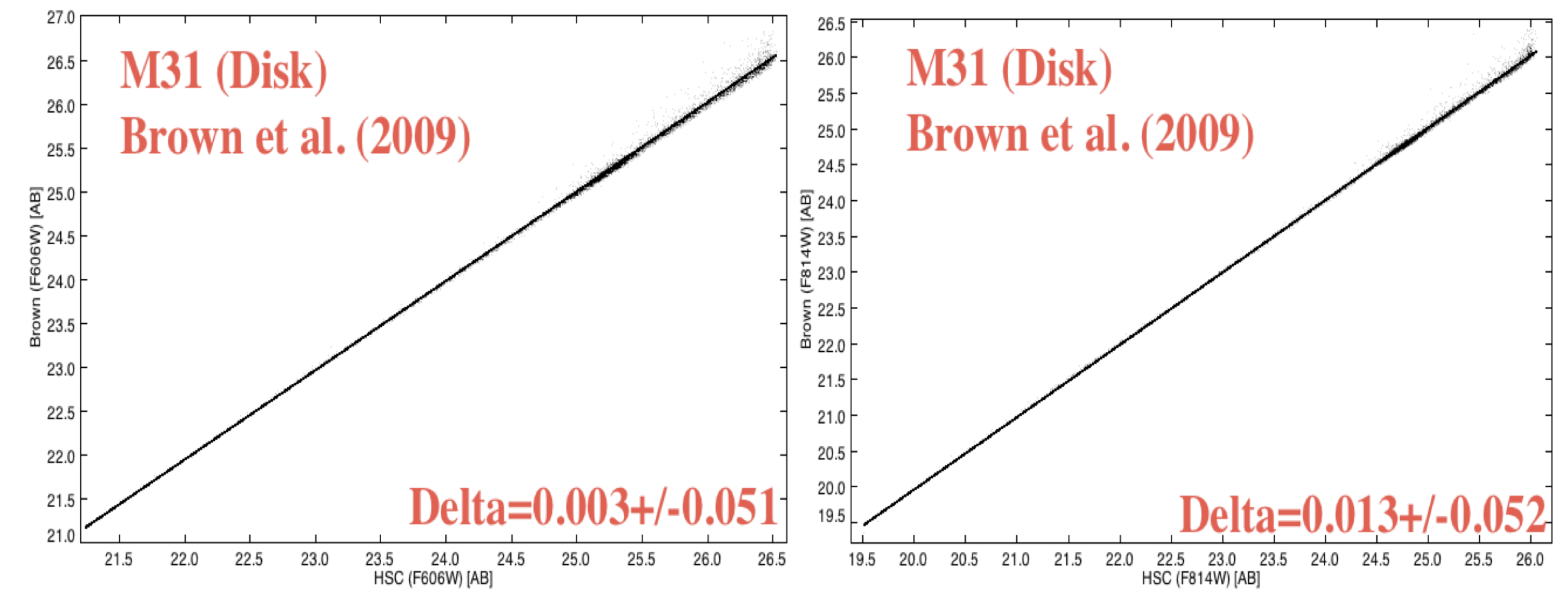
For our final photometric quality example we compare the HSC with
ground-based observations from the Sloan Digital Sky Survey (SDSS)
observations of galaxies in the Hubble Deep Field. Using MagAuto
(extended object photometry) values in this case rather than MagAper2
(aperture magnitudes), we find
generally good agreement with SDSS measurements. The scatter is typically a few
tenths of a magnitude; the offsets are roughly the same and reflect
the differences in photometric systems, since no transformations have
been made for these comparisons. The best comparison is between
A_F814W and SDSS-i. This reflects the fact that these two
photometric systems are very similar, hence the transformation is
nearly 1-to-1 .
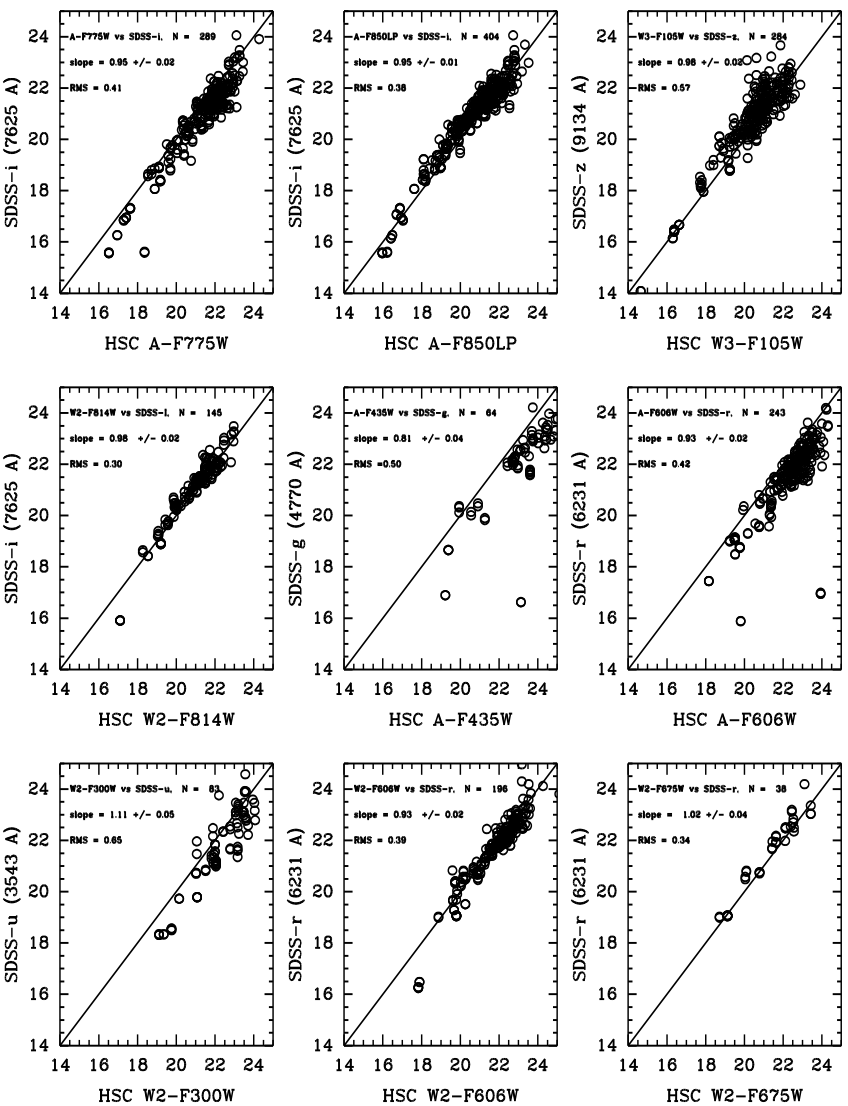
-
How does the HSC version 2 photometry compare with version 1?
 In this figure we compare photometry
from version 2 and version 1 in
a field in M31. This figure was made by requiring
the same individual measurements are present in
both versions, so that we are comparing "apples with apples". We find that the agreement is very
good, with typical uncertainties of a few hundreds of a magnitude.
Similar comparisons (e.g., in M87 where most
of the point-like sources are actually resolved
globular clusters) show similar results.
In this figure we compare photometry
from version 2 and version 1 in
a field in M31. This figure was made by requiring
the same individual measurements are present in
both versions, so that we are comparing "apples with apples". We find that the agreement is very
good, with typical uncertainties of a few hundreds of a magnitude.
Similar comparisons (e.g., in M87 where most
of the point-like sources are actually resolved
globular clusters) show similar results.
If we relax the constraint that the individual measurements be
available in both versions we find slightly worse agreement. In
particular, we find a tendency for version 2 to have larger values of
the RMS sigma values, as included in the summary form. This is
primarily due to the inclusion of fainter (noiser) measurements in version
2. However, we find that the mean, and especially the medians, are not
greatly affected.
A more detailed description of these comparisons will be included in
this section in the future.
-
What is the "Normalized" Concentration Index and how is it calculated??
In version 1, one of the items in the List of "Known Problems" was that raw values of the Concentration Index (the difference in magnitude for aperture photometry using magaper1 and magaper2) were added together to provide a single mean value in the summary form. The reason this is a problem is that
each instrument/filter combination has a different normalization. For example, the
Peak of Concentration Index for Stars and Aperture Correction Table
shows the raw values of the
concentration index for stars is 1.08 for the ACS_WFC_F606W filter,
0.88 for WFC3_UVIS_F606W and 0.86 for
WFPC2_F606W. Similarly, the raw values of the
concentration index vary as a function of
wavelength for some detector. For example,
WFC3_F110W has a peak value of 0.56 while
WFC3_160W has a value of 0.67.
Hence, averaging the mean values of the Concentration Index together in Version 1
resulted in values that were not always very useful, and were often
misleading.
In version 2 we have corrected this by
normalizing (dividing by) the value of the peak of the raw concentration index for stars using observations from each instrument and
filter, as provided
in the table listed above. The values are then averaged together to
provide an estimate of the "Normalized" Concentration Index, which is listed as the value of CI in
version 2 of the
summary form.
Hence, objects with values of CI ~ 1.0 are likely to
be stars while sources with much larger values of CI are likely to be
extended sources, such as galaxies. There are cases where this is still not true (e.g., saturated stars, cosmic rays, misaligned exposures within a visit, ...), hence caution is still required when using values of CI.
-
How good is the astrometry for the HSC?
This plot from version 1 shows (in blue) the distribution of the relative astrometric
errors in the HSC corrected astrometry, as measured by the positional
offsets of the sources contributing to multi-visit matches from their
match positions. The
units for the x-axis are milli-arcsec (mas). The y-axis is the number
of sources per bin that is 0.1 mas in width. Plotted in orange is the corresponding
distributions of astrometric errors based on the original HST image
astrometry.
The peak
(mode) of the HSC corrected astrometric error distribution in HSC version 1 was 2.3 mas,
while the median offset was 8.0 mas. The original, uncorrected (i.e., current HST)
astrometry has corresponding values of 9.3 mas and 68 mas,
respectively.
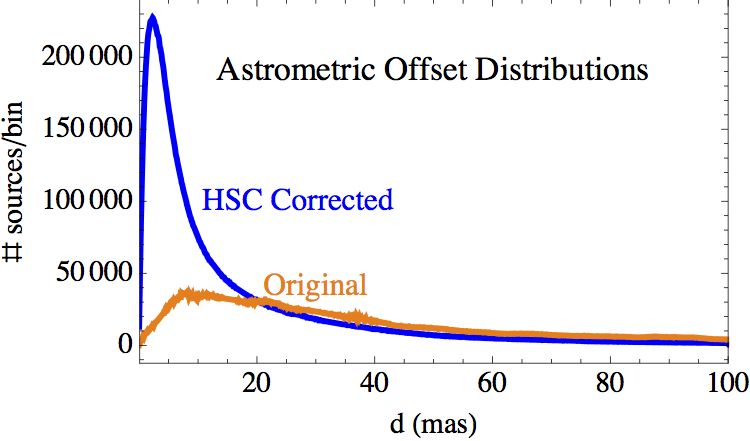
The following two figures show the corrected
astrometric offset distributions for the different instruments
for multi-visit matches in the HSC for version 1 and version 2.
The distribution is actually flatter for version 2, largely due to the inclusion of fainter
ACS sources with correspondingly larger pointing uncertainties. Also note the large increase in the number
of ACS/WFC sources, due both to the deeper source lists and the addtion of four more years of data!
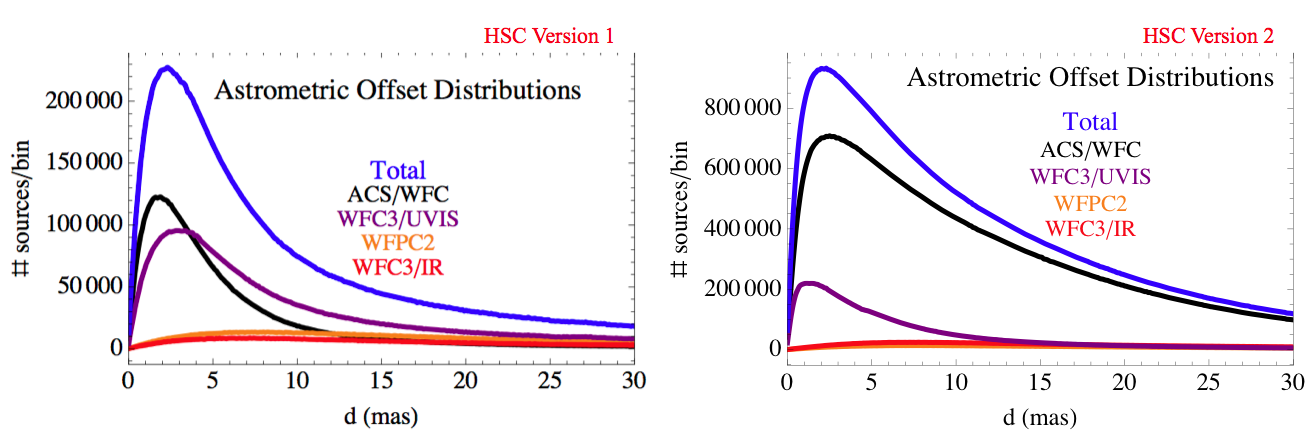
As expected, the
instruments with smaller pixels (ACS [50 mas] and WFC3/UVIS [40 mas])
show the best astrometric accuracy, with a peak less than a few mas
and typical values less than 10 mas. On the other hand, the
instruments with larger pixels WFPC2 [100 mas on the WFC chips which
dominate the statistics] and WFC3/IR [130 mas], have much larger
astrometric uncertainties, with less than 10 mas peaks and typical
values that are less than 20 mas.
Several astrometric studies are currently being analyzed and will be added to this FAQ in the future.
-
How does the HSC compare with Gaia astrometry?
This figure shows a small portion in the outskirts of 30 Dor. There are 17 Gaia sources (blue) in this region and 96 HSC sources (pink) with NumImages > 10. There would be 279 HSC sources if we used a NumImages > 5 criteria to reach fainter sources. This figure shows good agreement in the positions of HSC relative to Gaia for this field. More detailed analysis are currently underway and will be added to this section in the future.
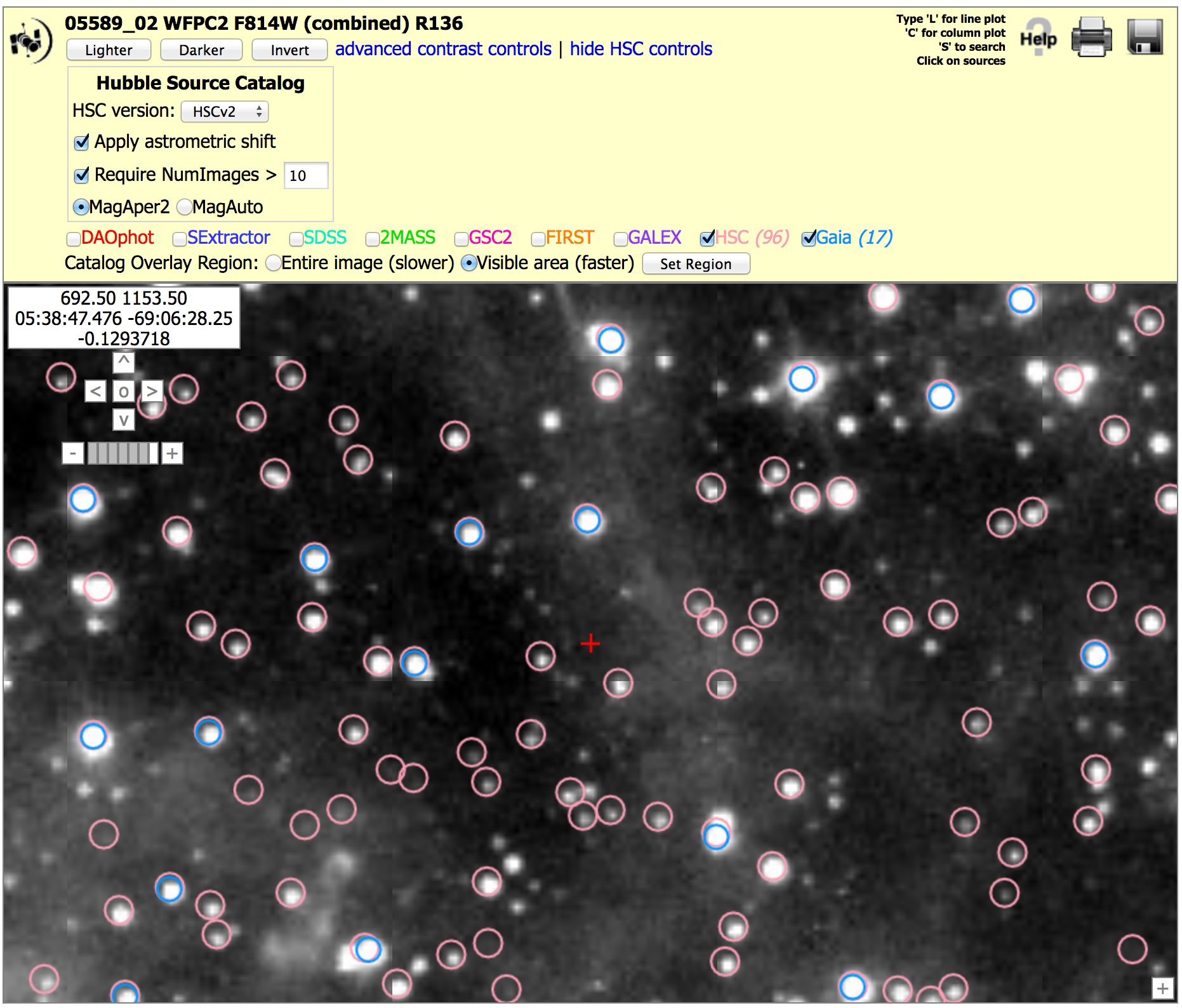
-
What are the future plans for the HSC?
-
Improve the WFPC2 sources lists using the newer ACS and WFC3 pipelines.
-
Address the known problems in HSC Version 2.
-
Integrate the Discovery Portal more fully with the HSC.
-
Use mosaic-based (rather than visit-based) source detection lists, and perform forced photometry at these locations on all images.
 General
General
 About Images and Matches
About Images and Matches
 About Spectroscopic Cross Matching
About Spectroscopic Cross Matching
 About Accessing the HSC
About Accessing the HSC
 About Quality
About Quality
 About Use Cases and Documentation
About Use Cases and Documentation
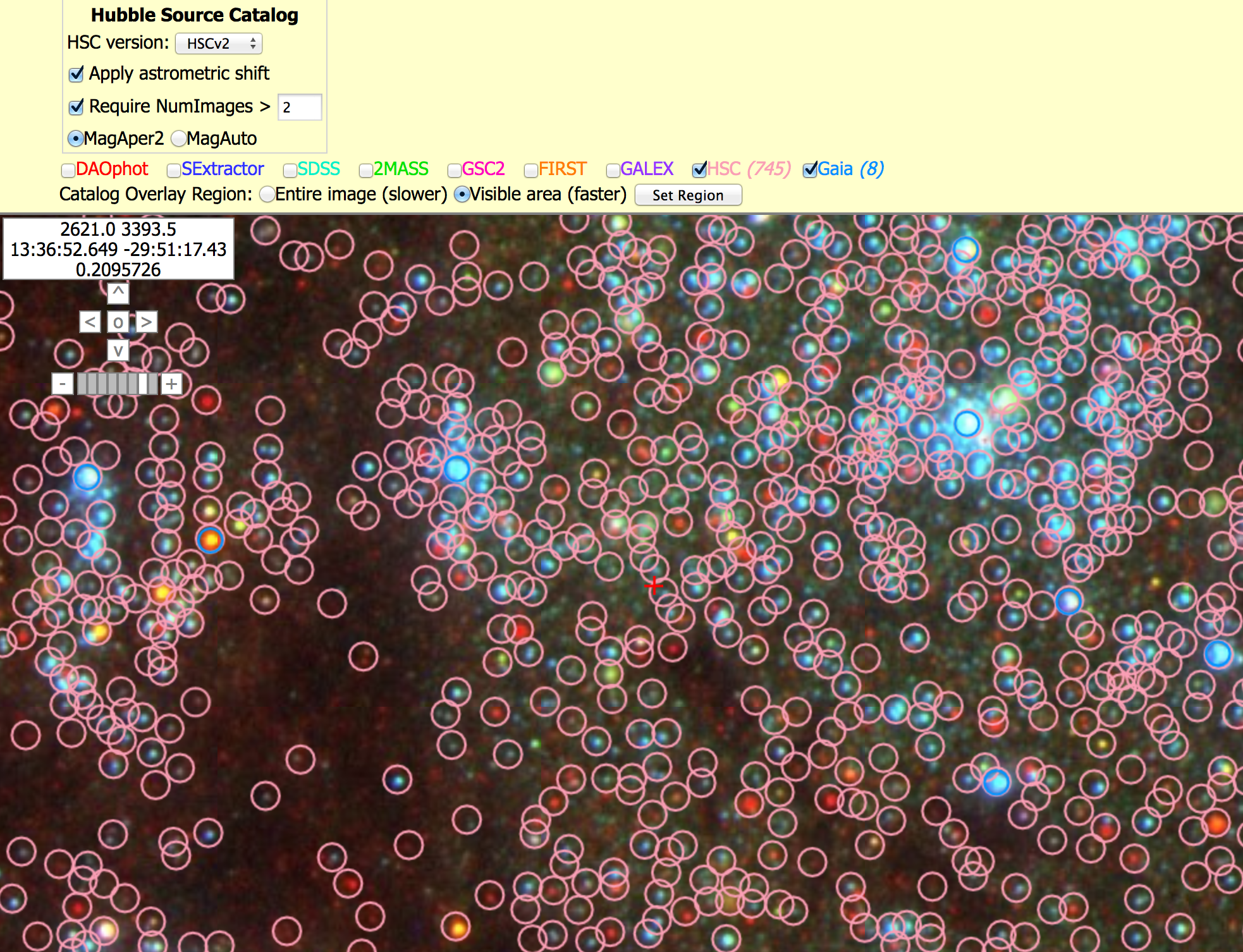
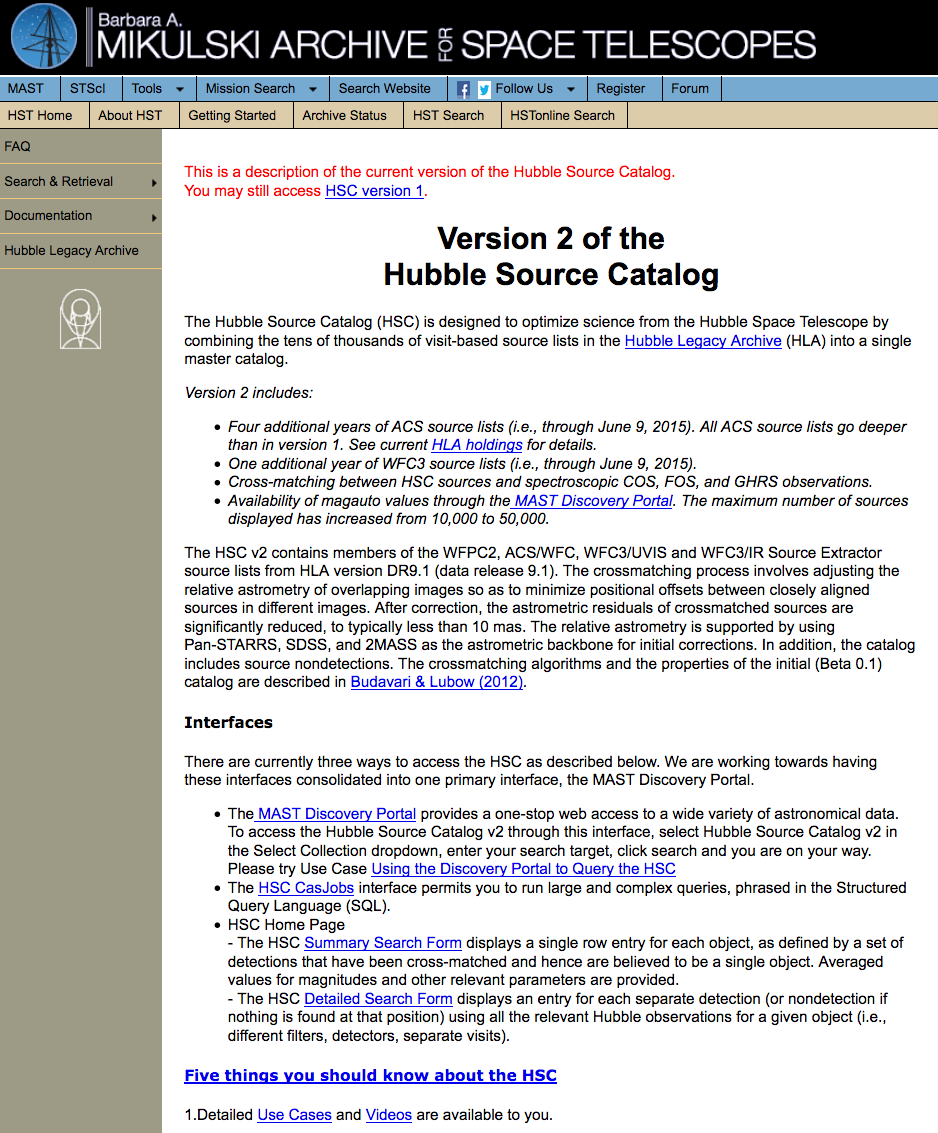
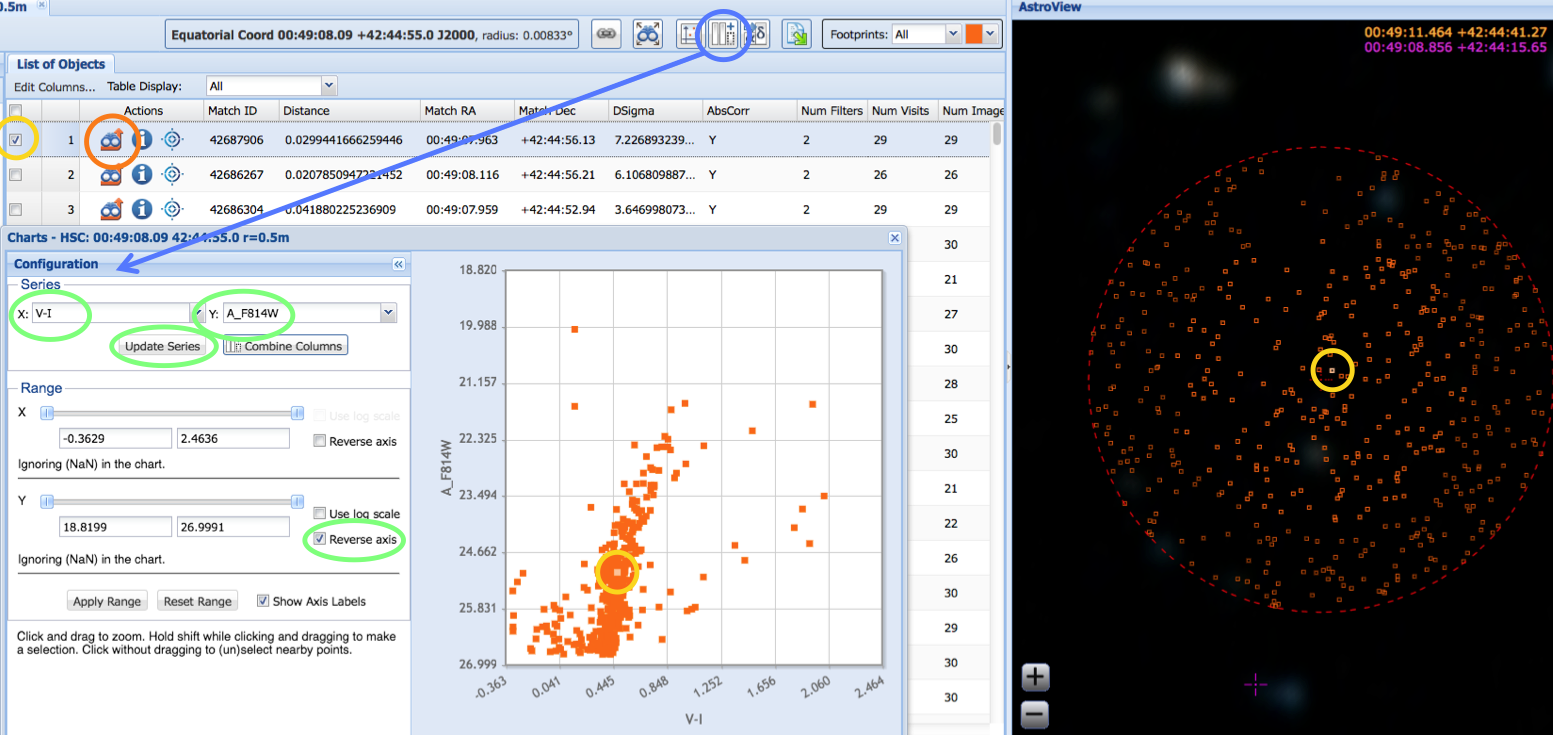


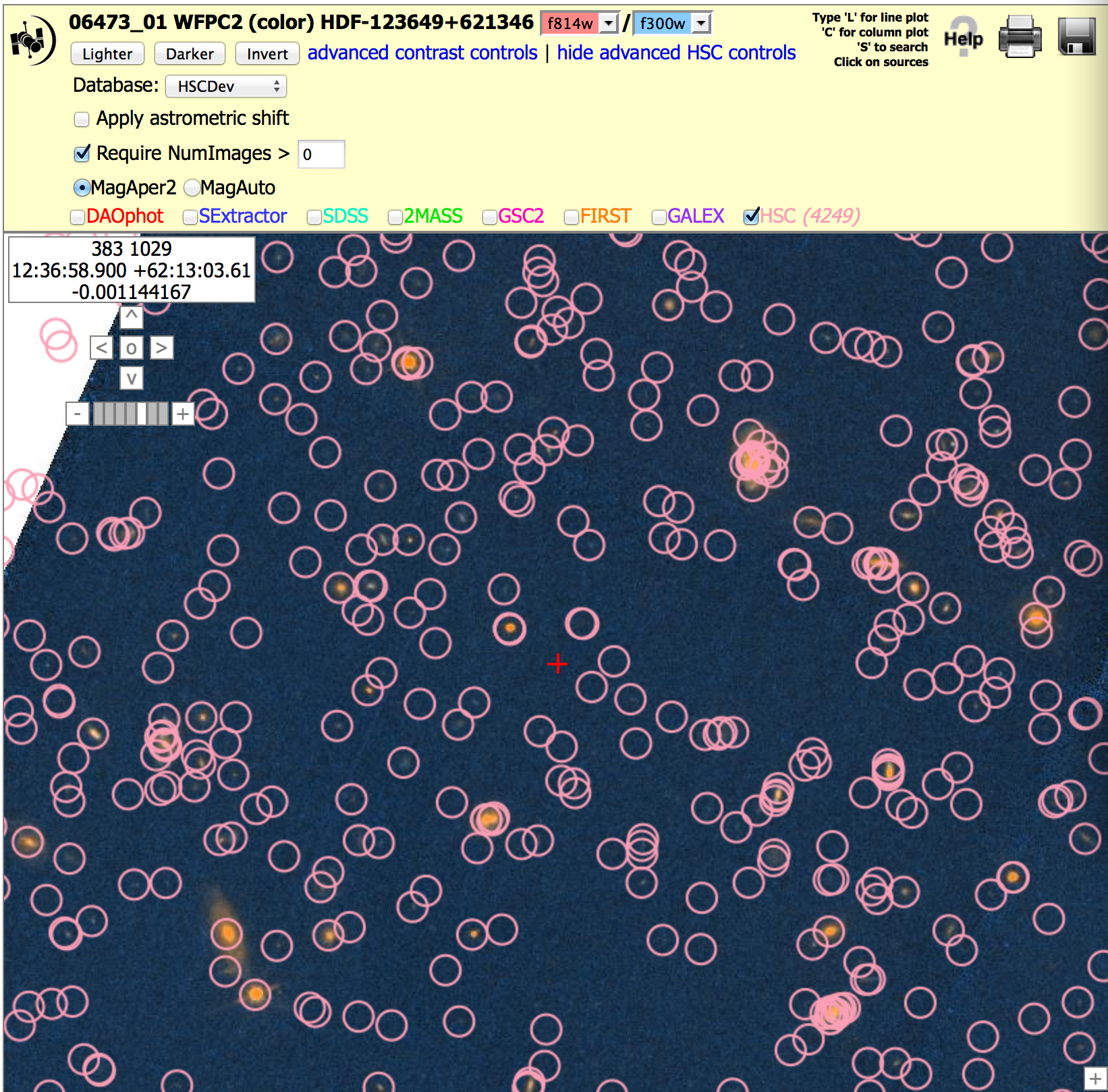
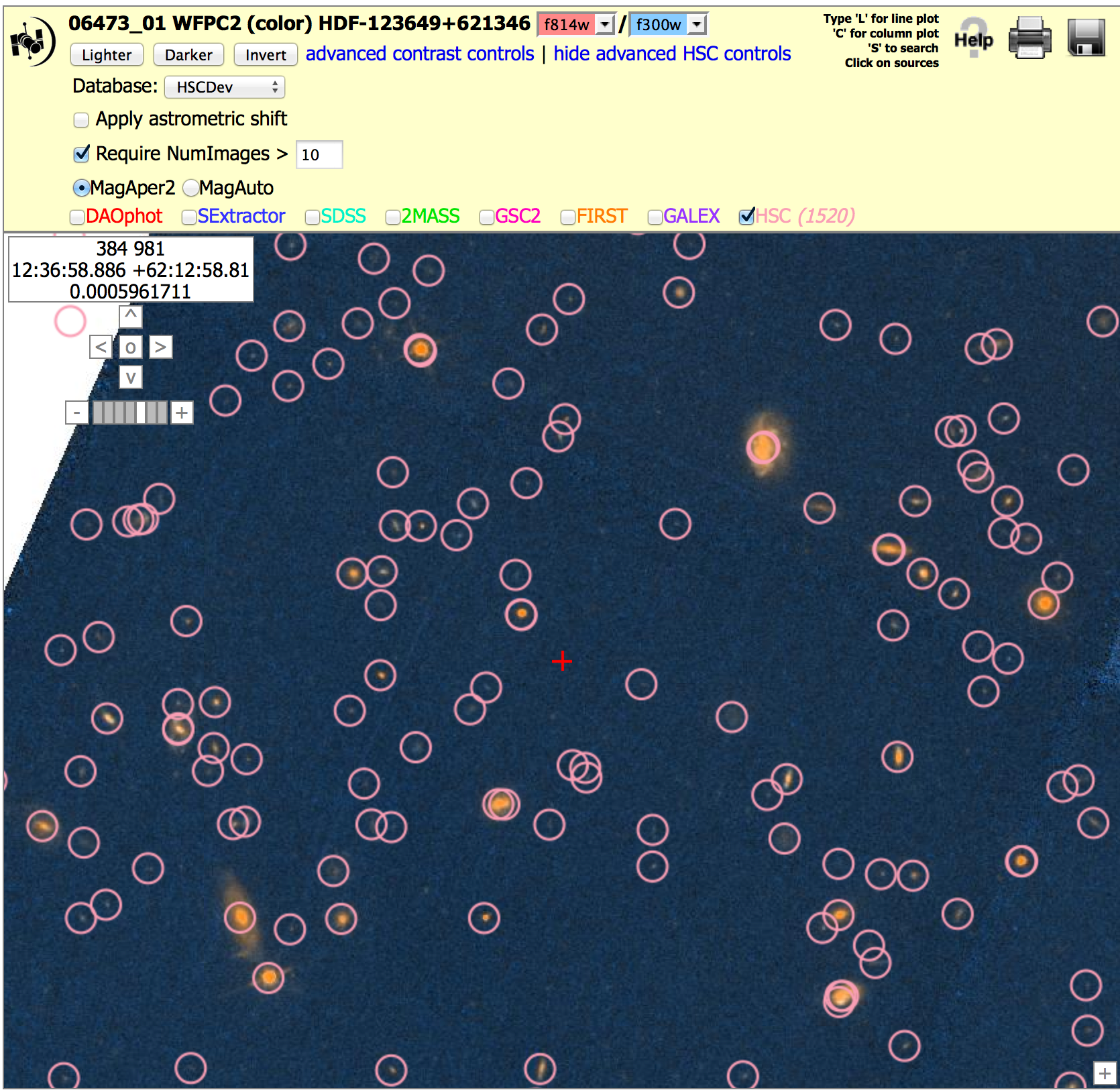
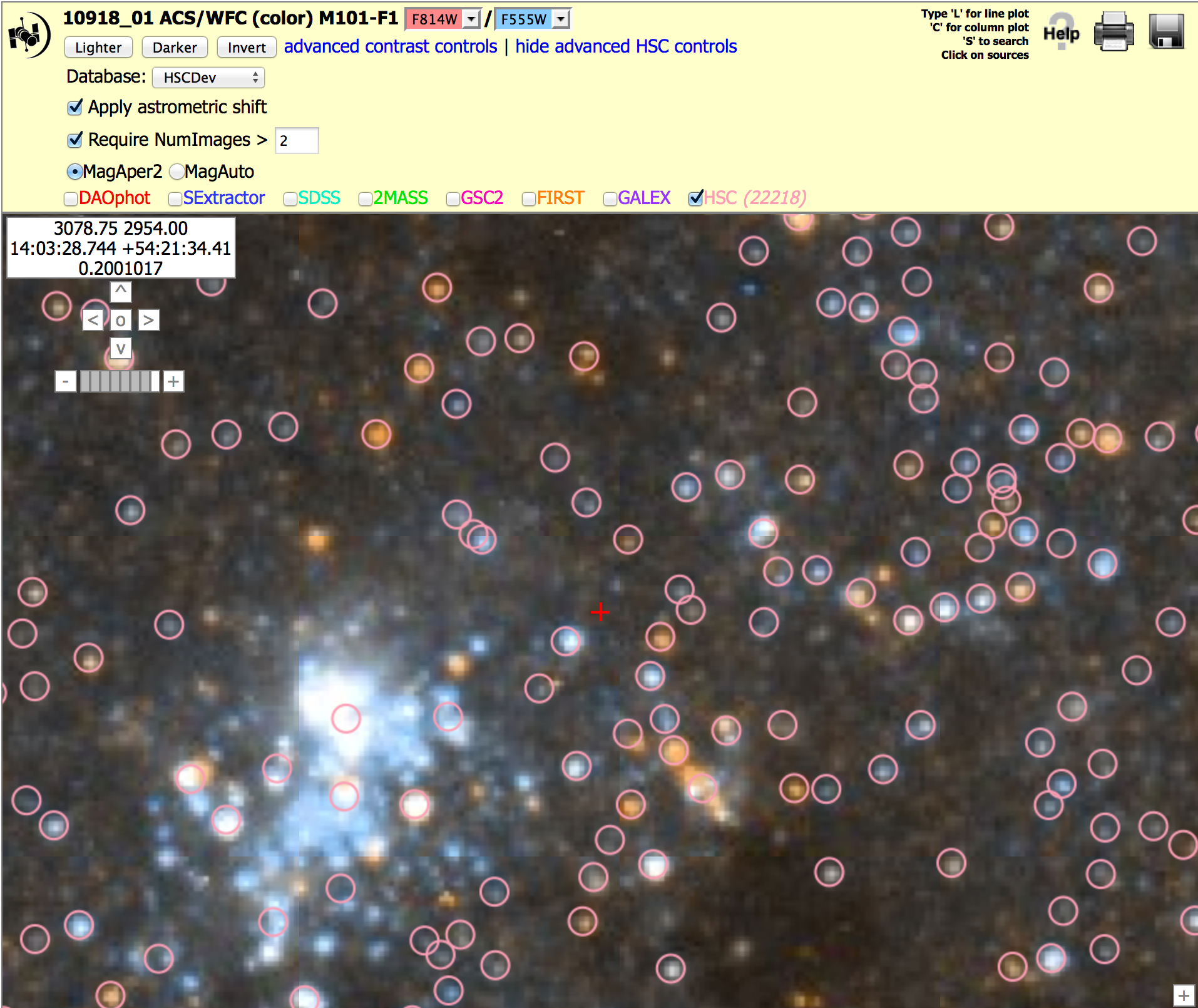

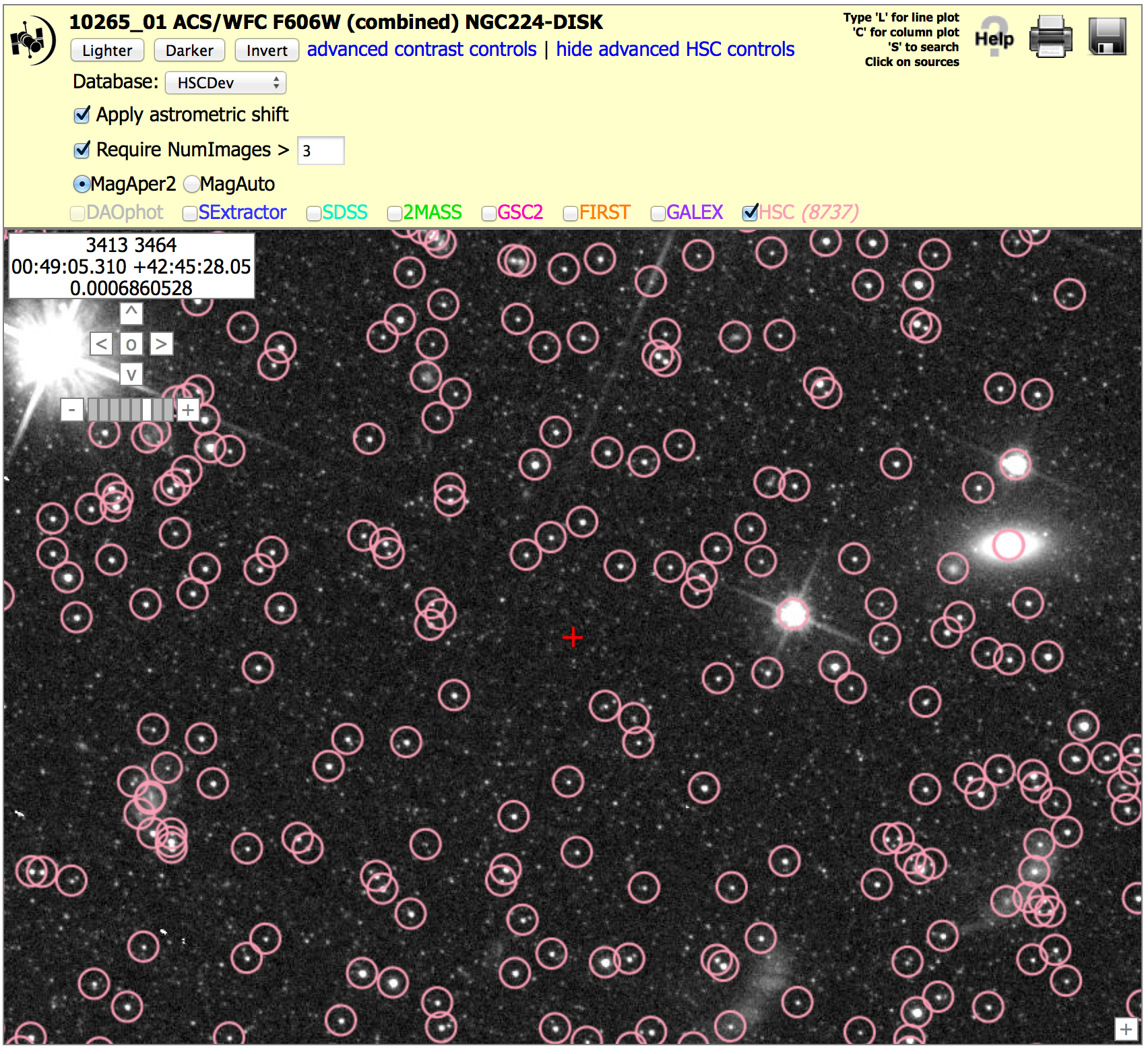
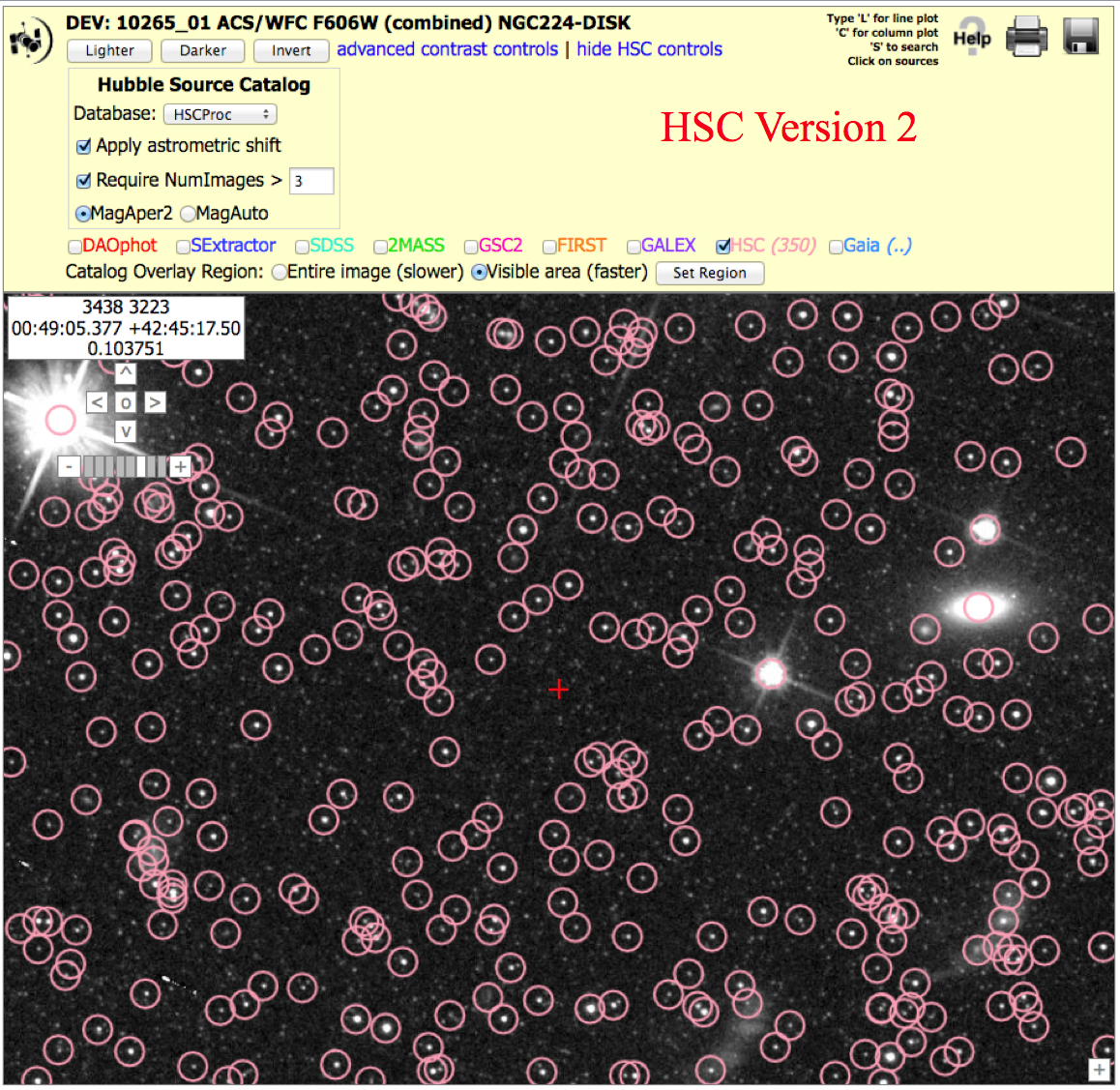
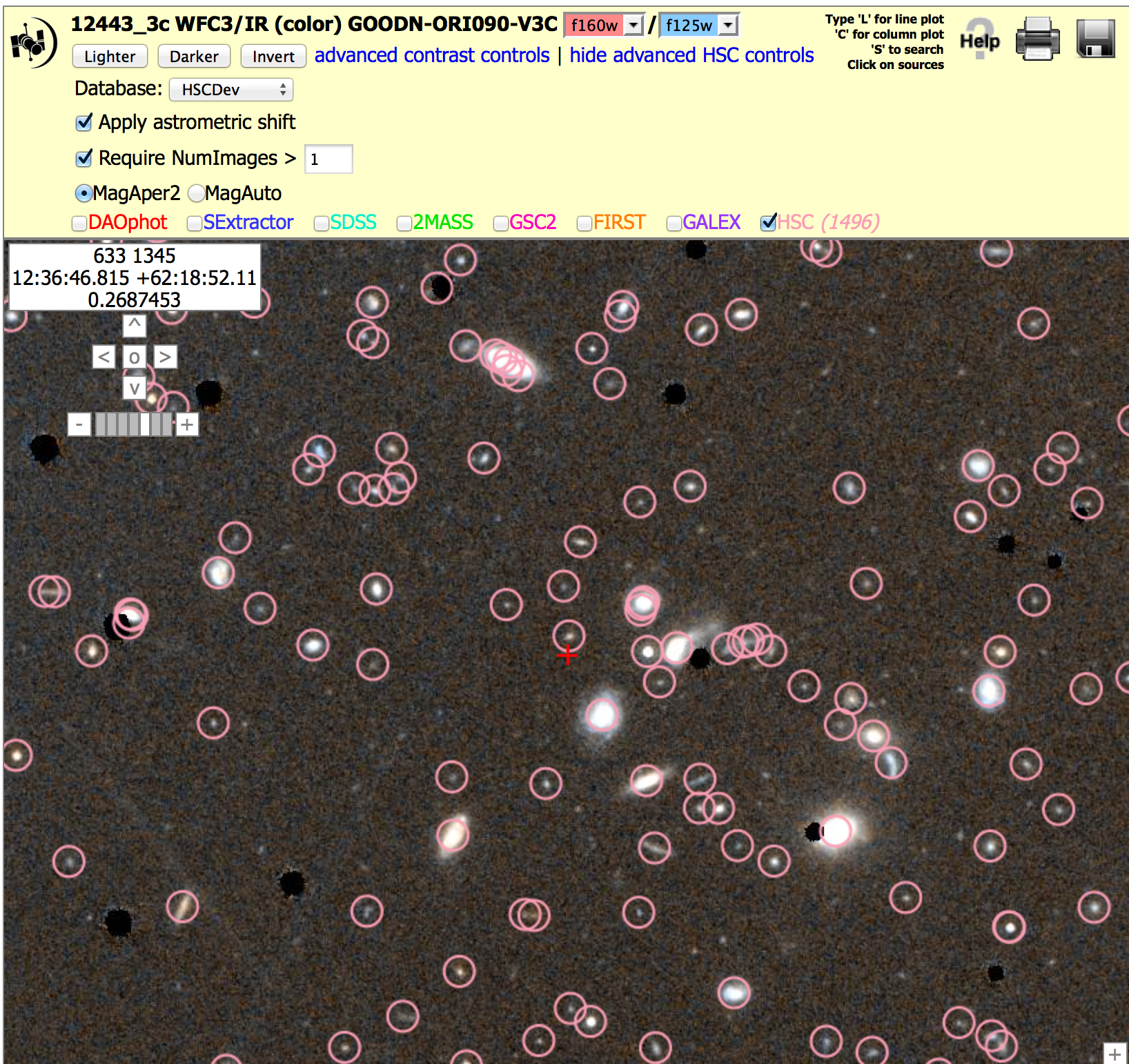
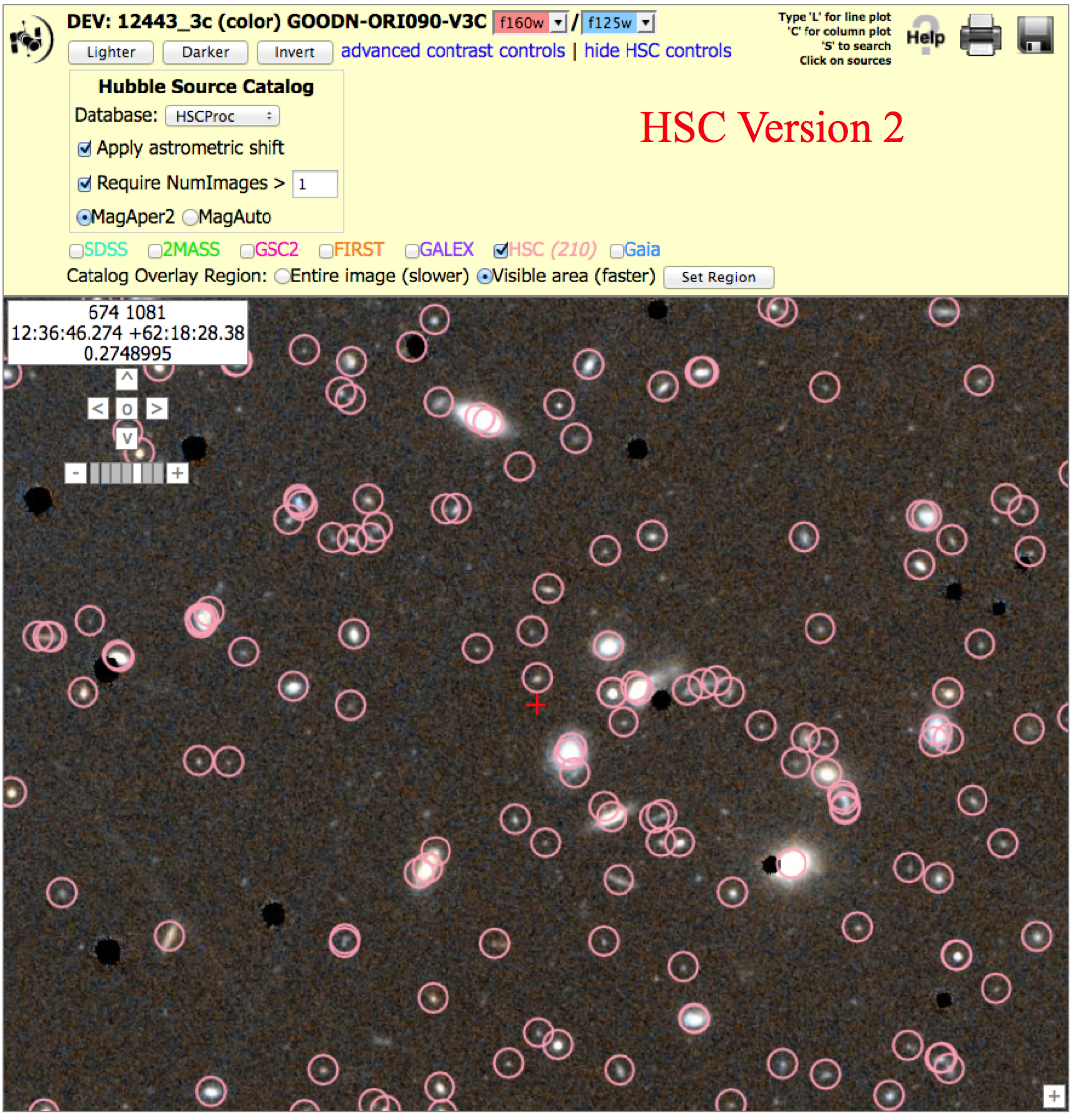
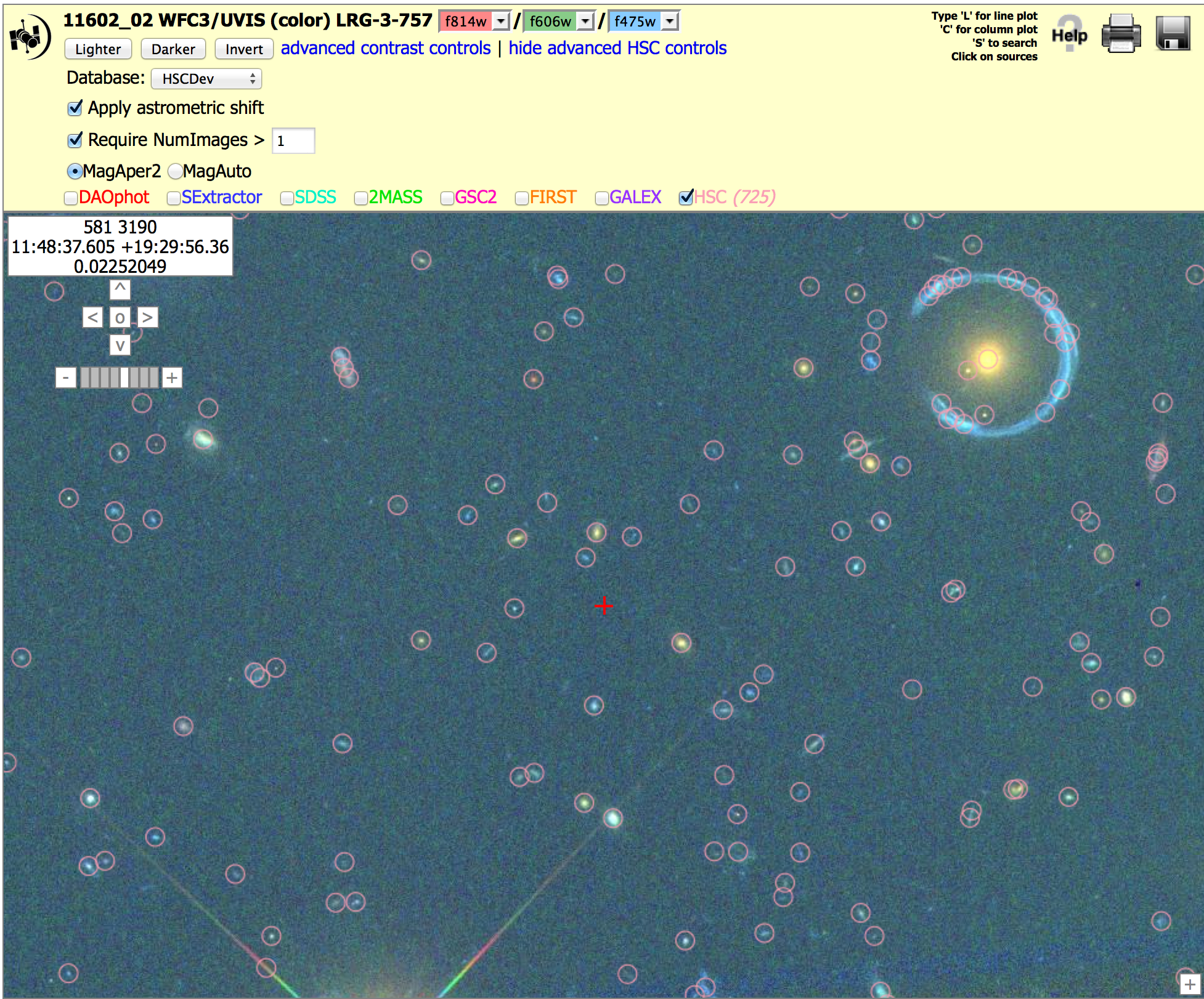
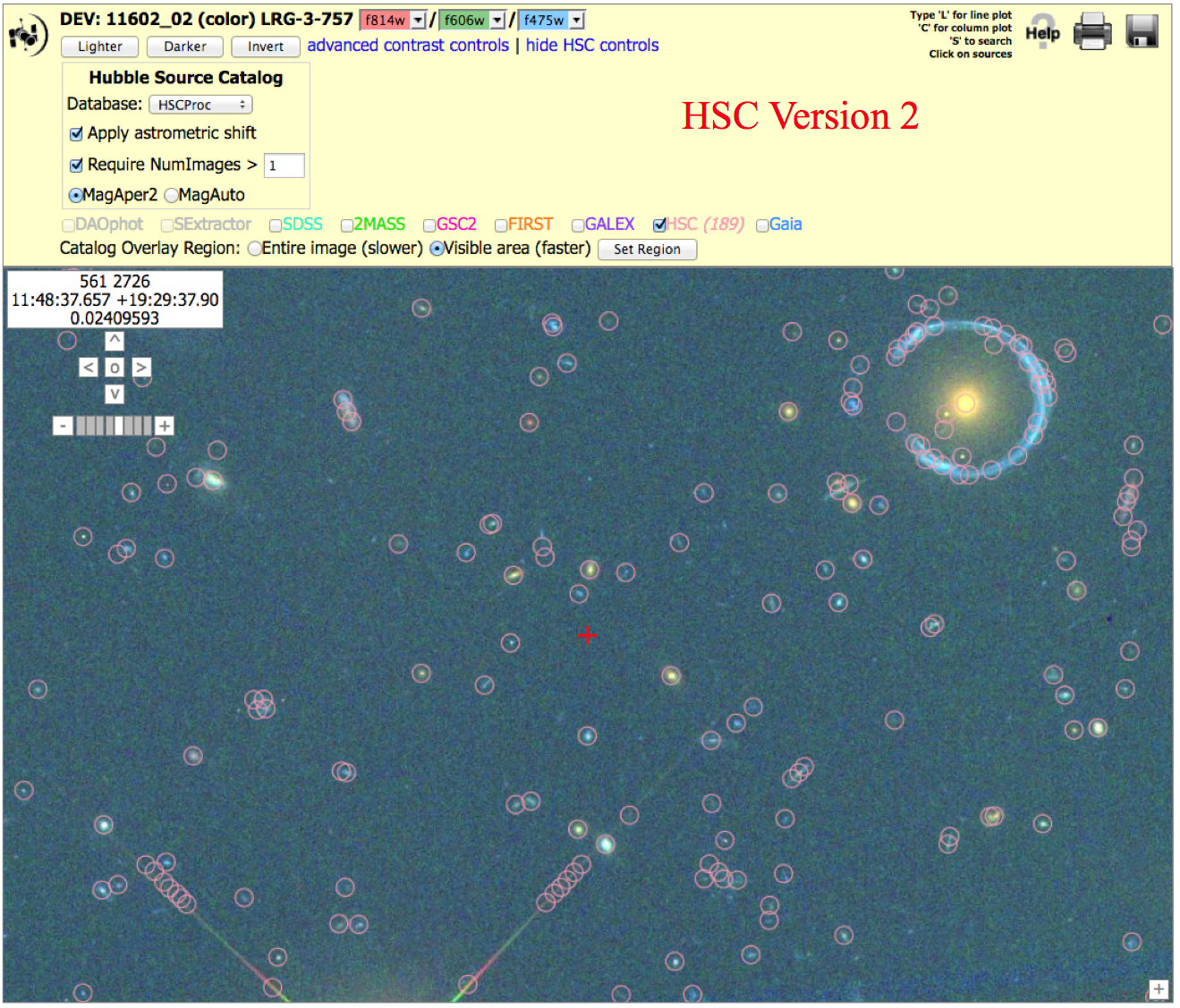
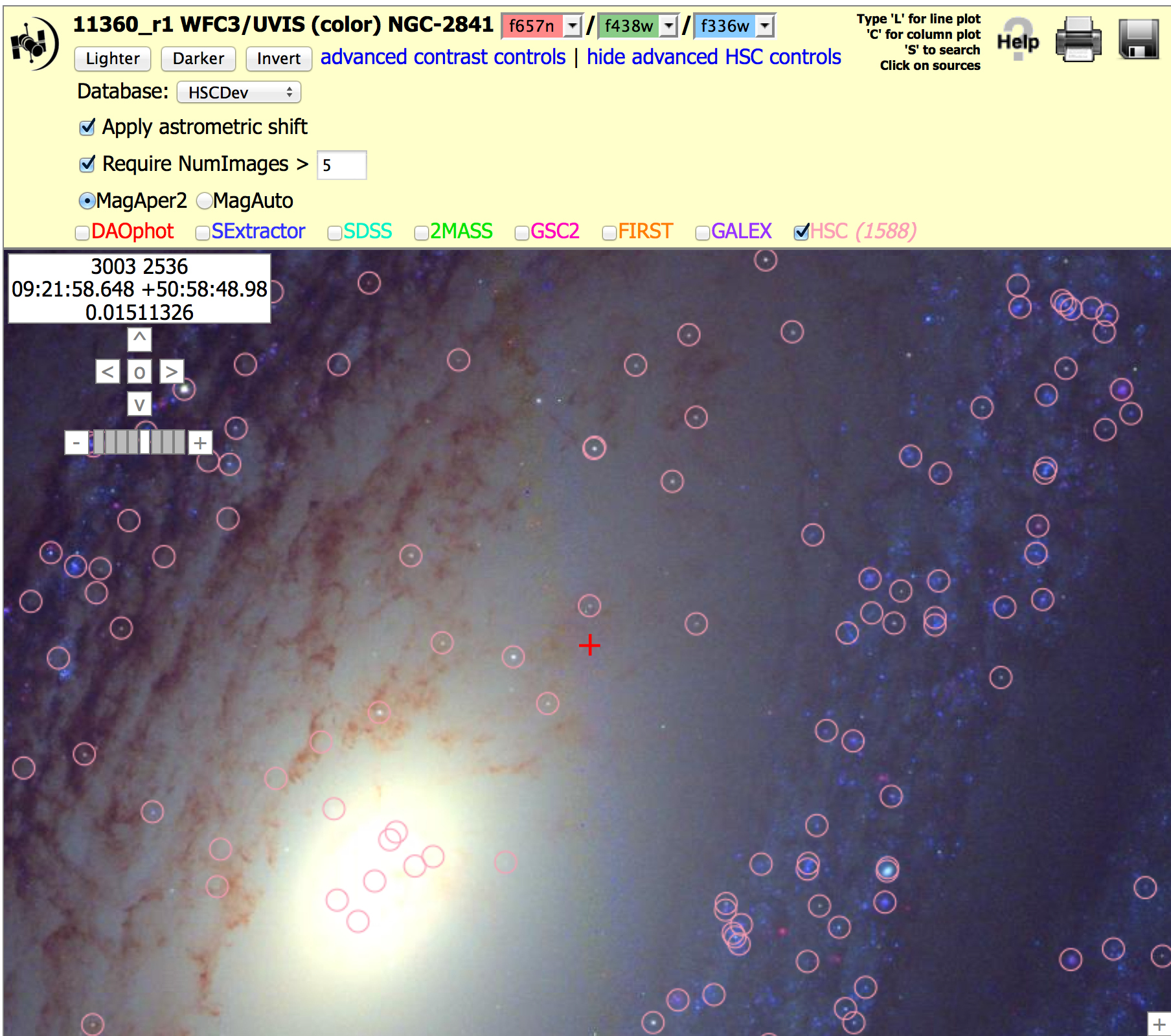
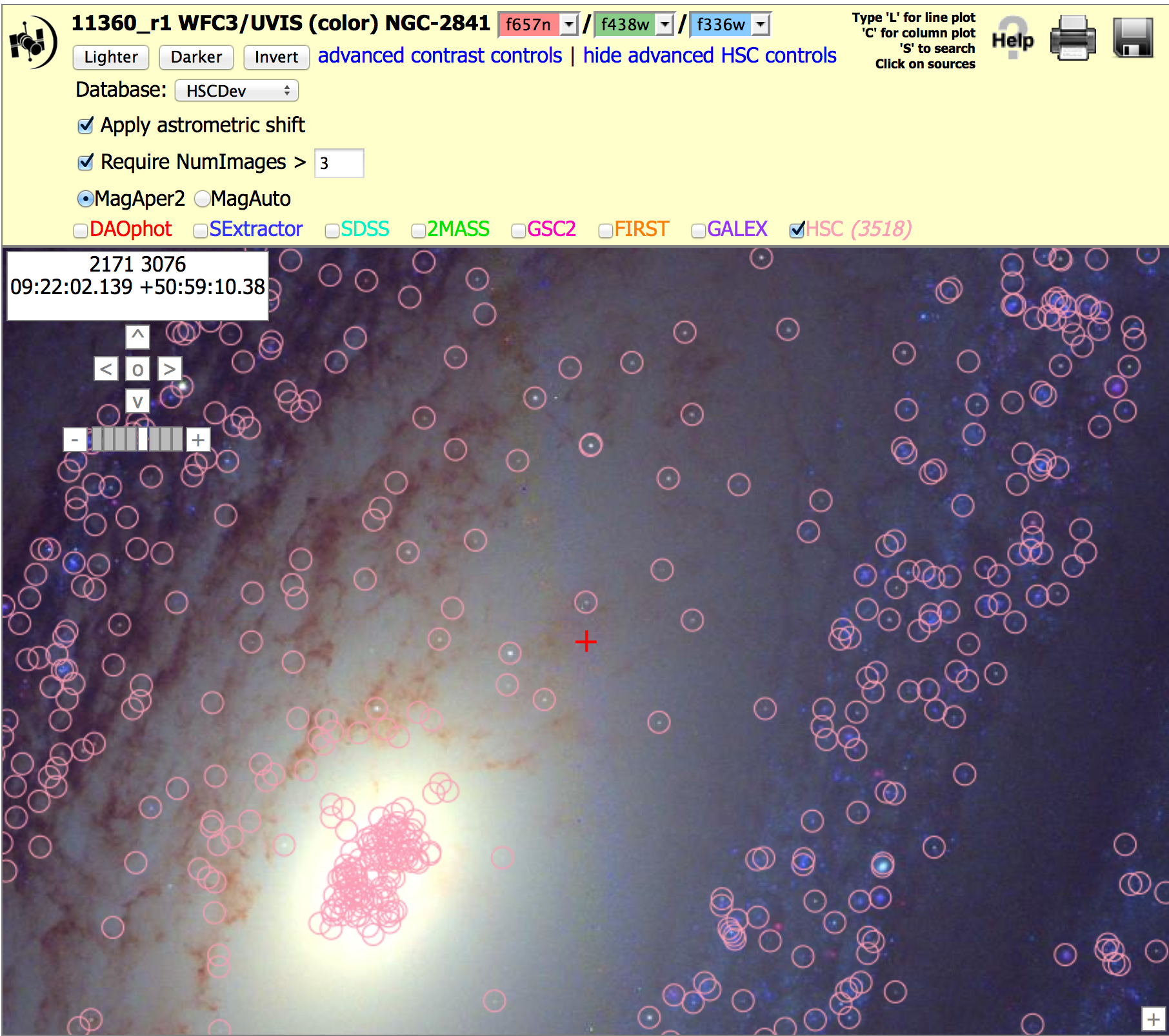
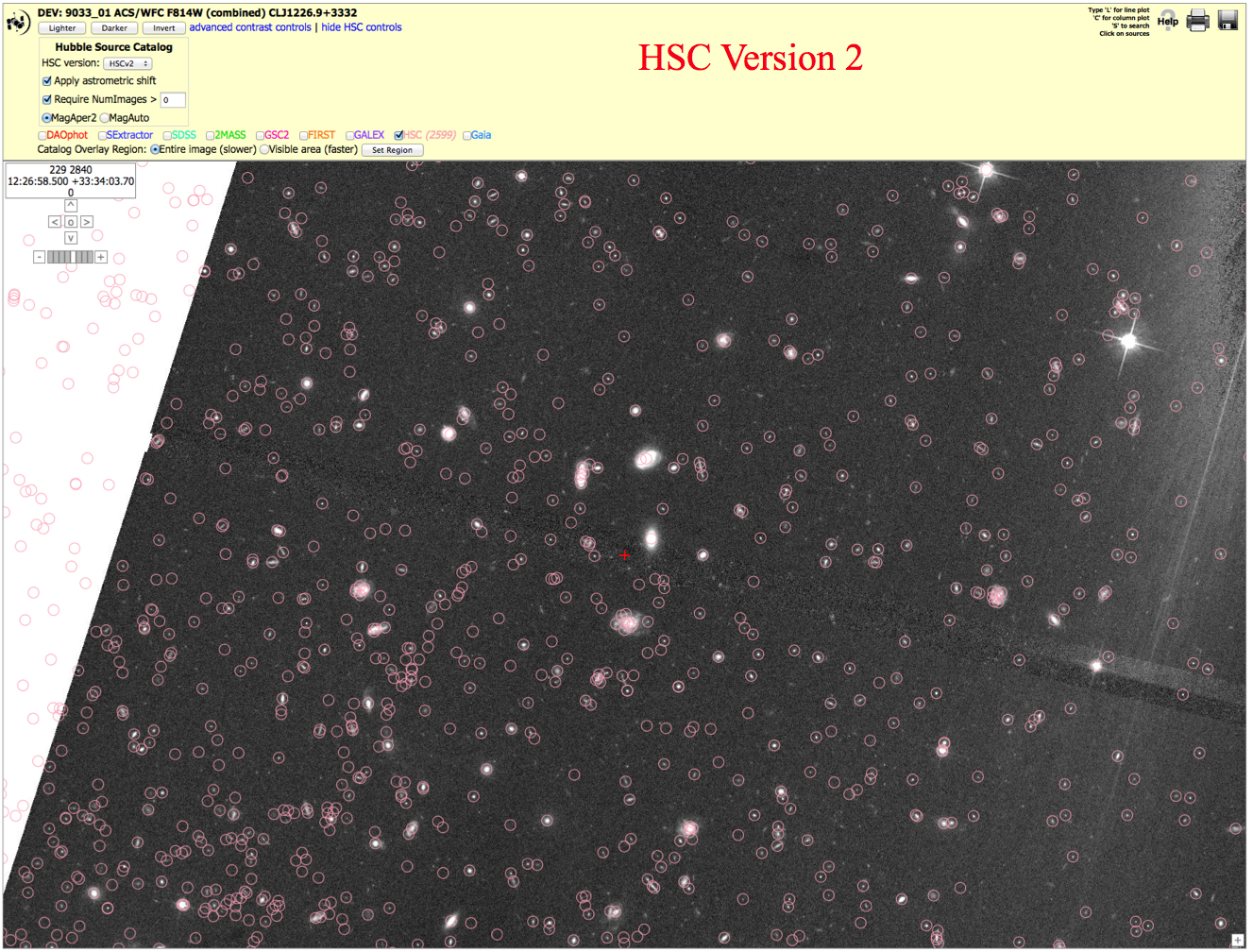
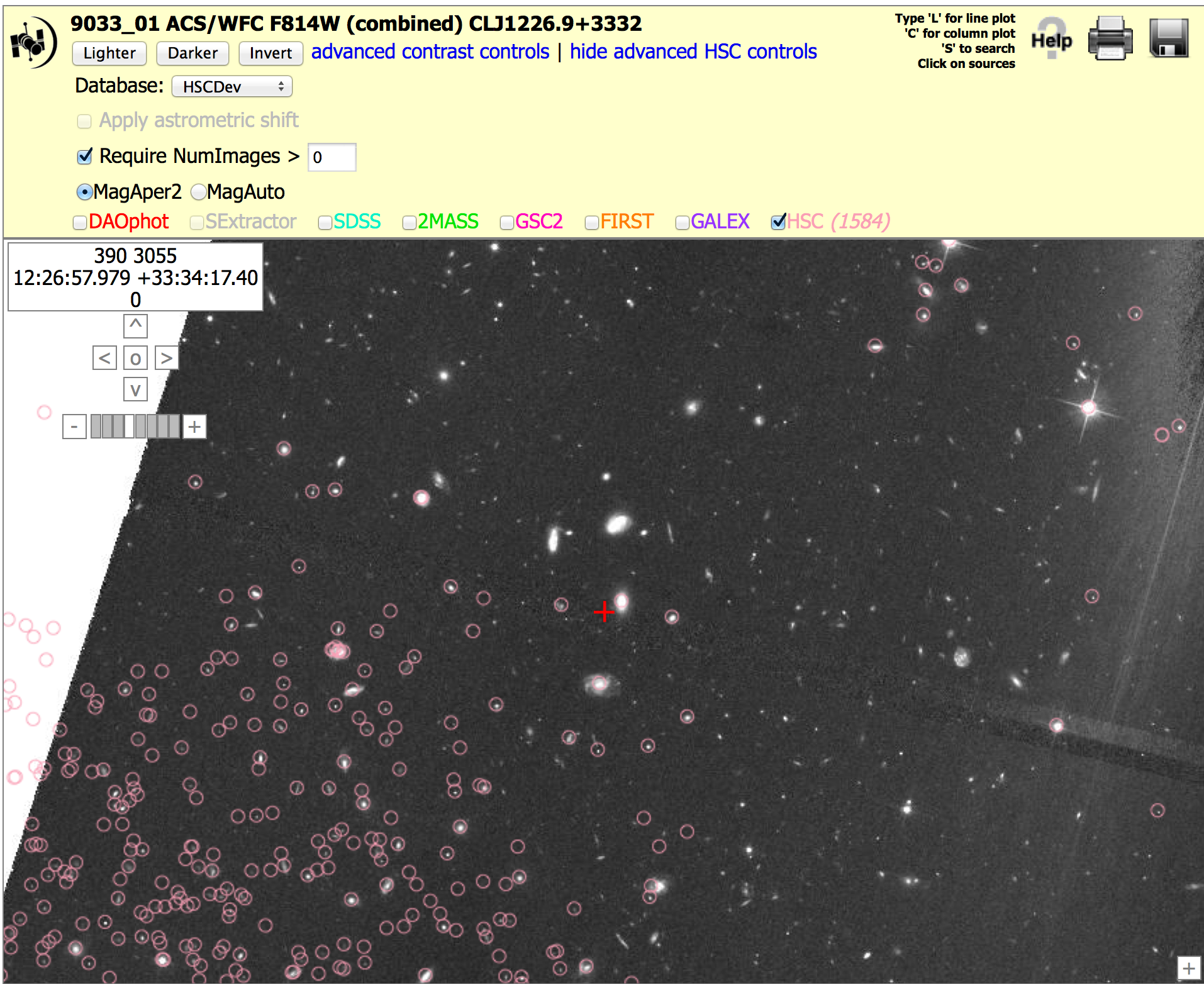
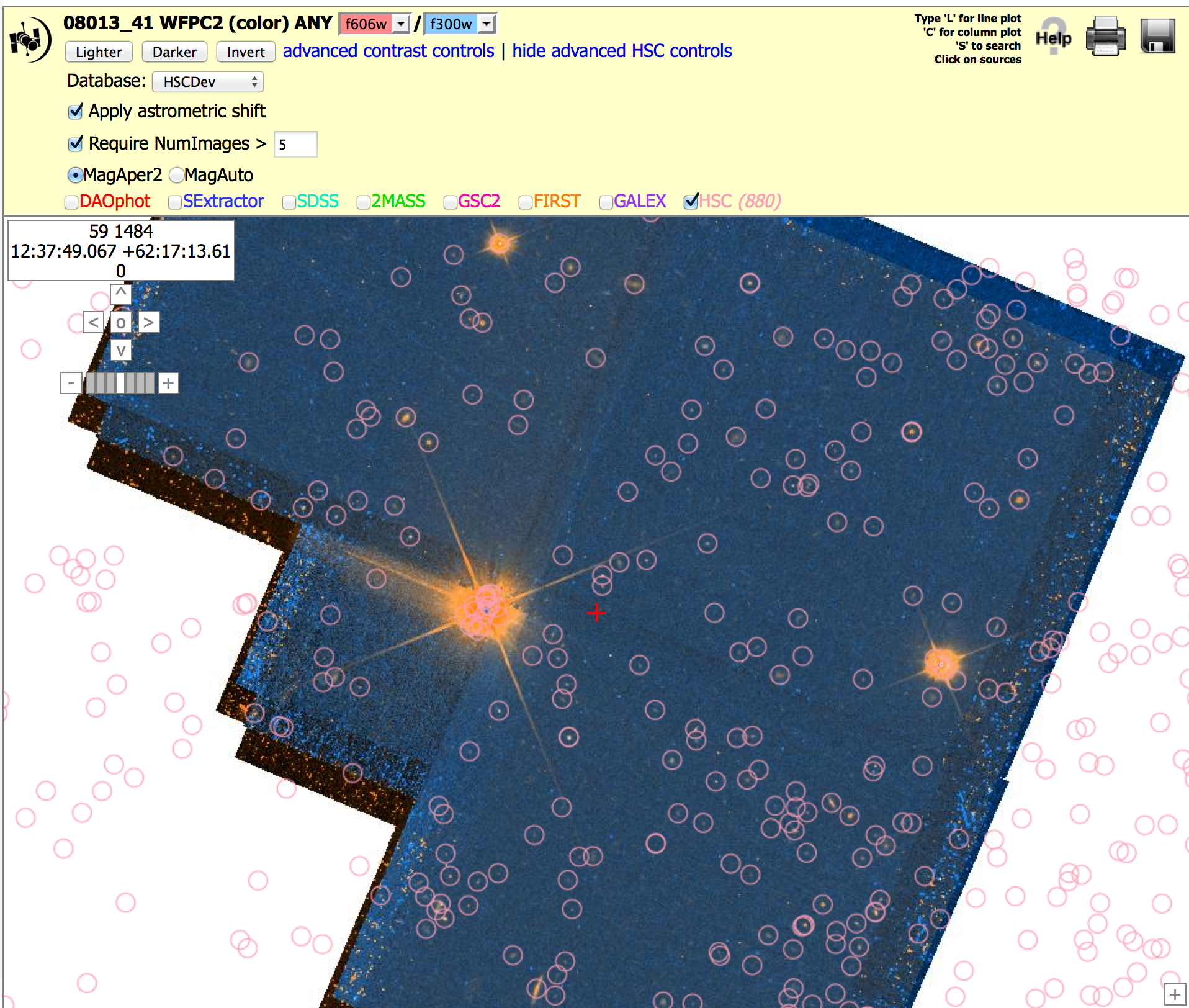
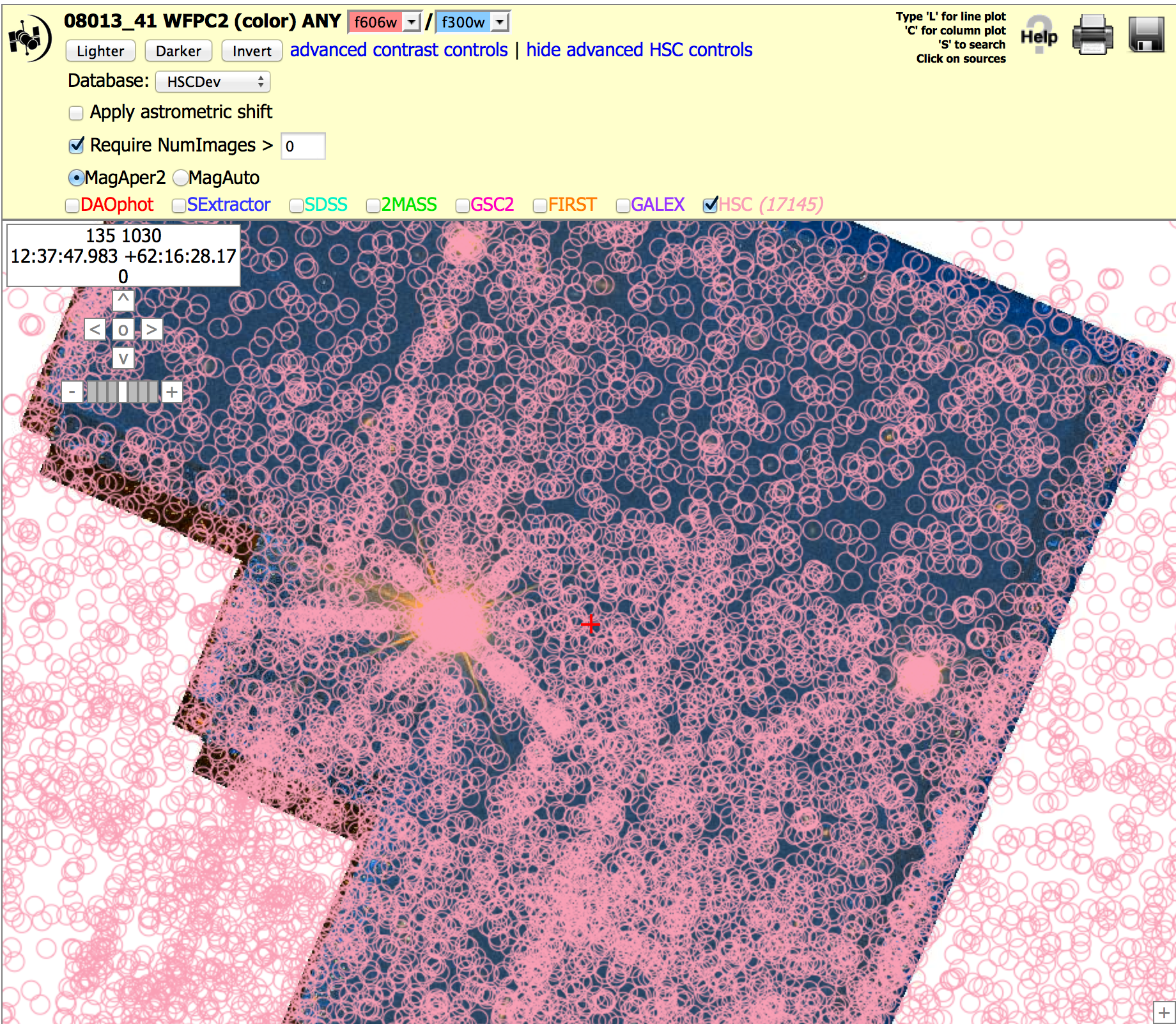
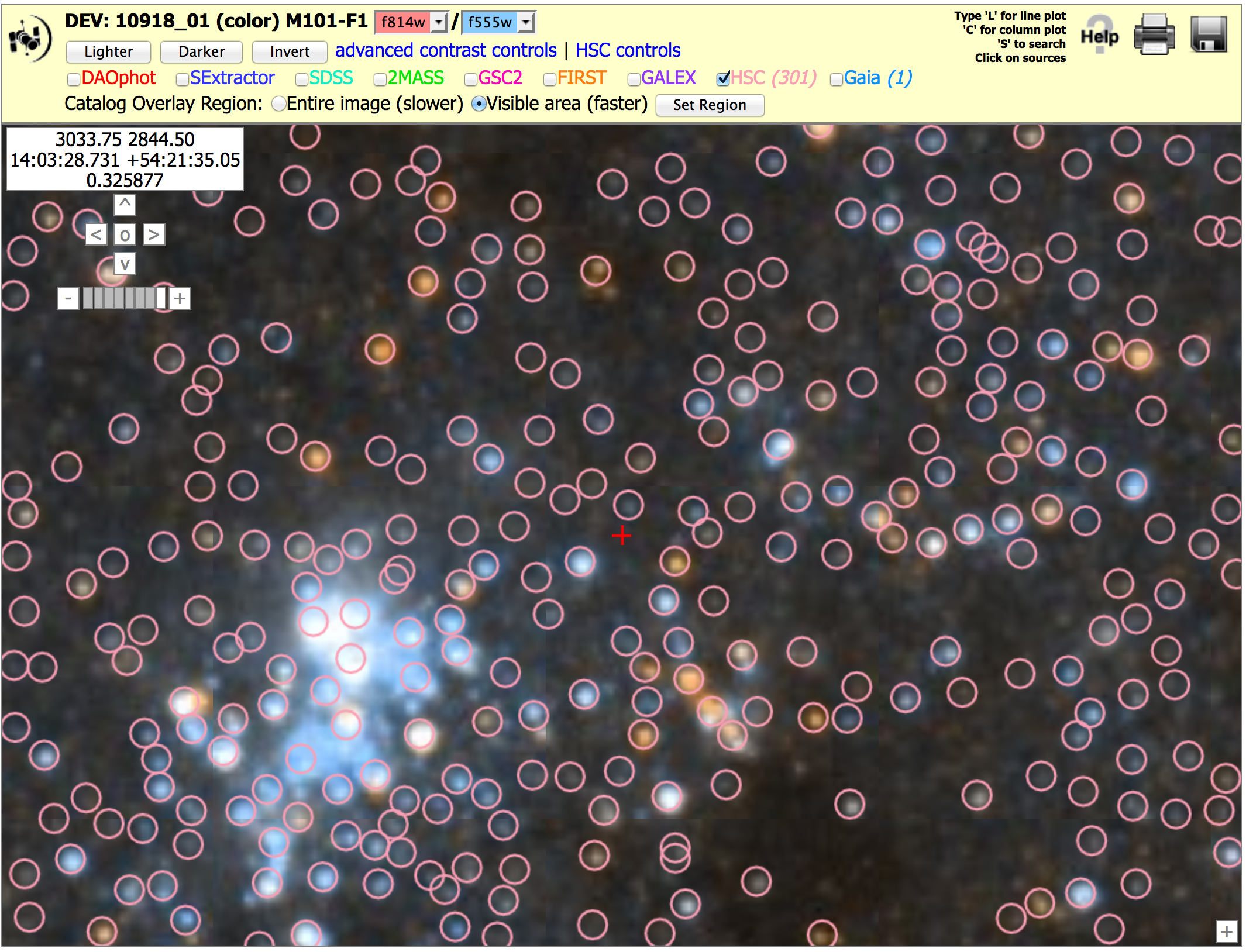
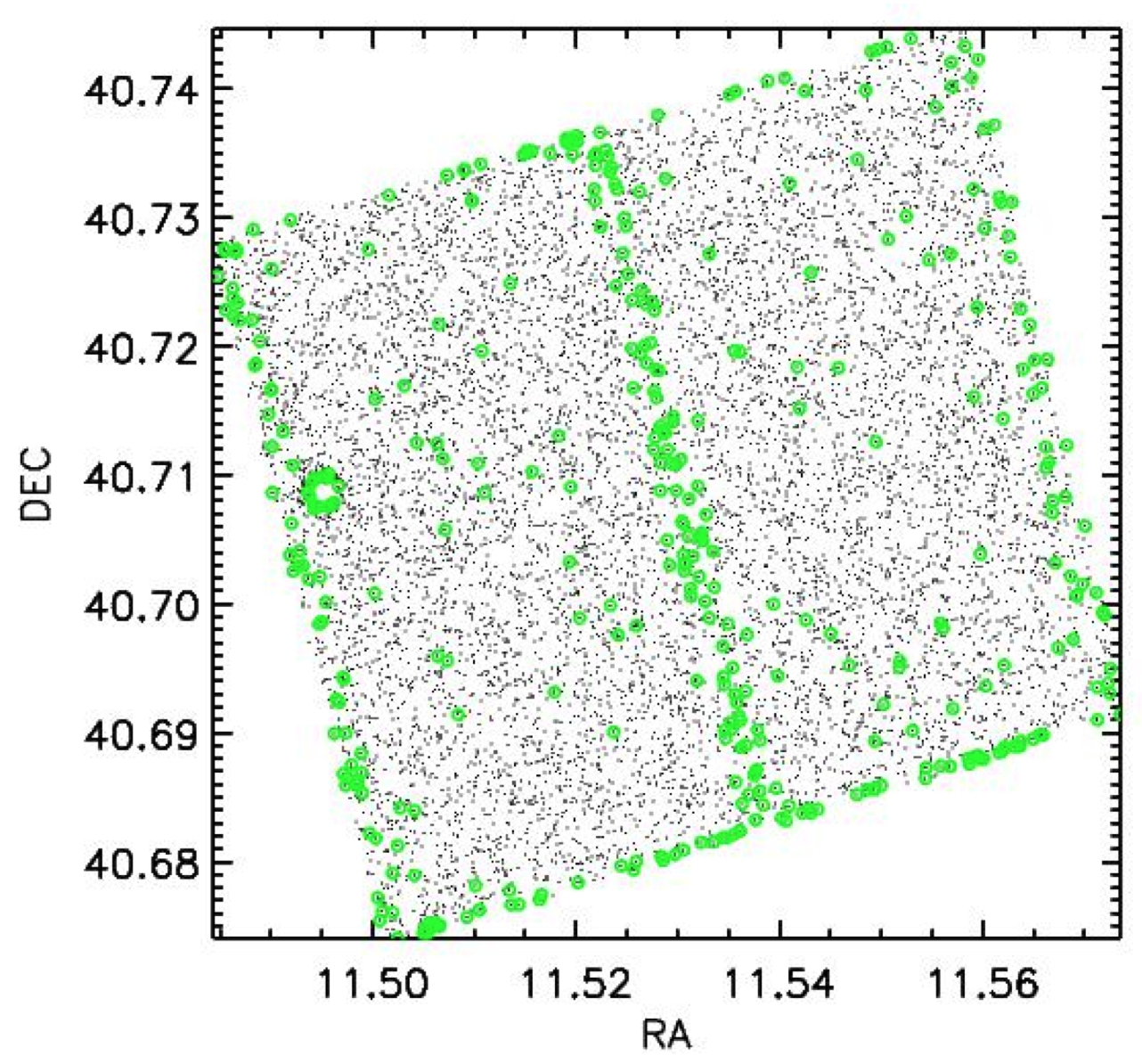 This figure is the byproduct of a project to find variable stars
by searching for outliers in photometric light curves. It reveals that the
photometry along the edges, and the chip gap between detectors, are
photometrically degraded in some images, with outliers that can be mistaken as
potential variables (i.e., the green points). While this complicates the ability to find
variables in these areas, the effect on mean photometric values is believed to be
relatively small in most cases. However, we caution users to be aware of this potential
issue by examining their results for potential edge effects.
The effect appears to be due to insufficient masking along the edges and gaps, but is still under
investigation.
A more detailed analysis of the effect on photometry will be included in this section in the future.
This figure is the byproduct of a project to find variable stars
by searching for outliers in photometric light curves. It reveals that the
photometry along the edges, and the chip gap between detectors, are
photometrically degraded in some images, with outliers that can be mistaken as
potential variables (i.e., the green points). While this complicates the ability to find
variables in these areas, the effect on mean photometric values is believed to be
relatively small in most cases. However, we caution users to be aware of this potential
issue by examining their results for potential edge effects.
The effect appears to be due to insufficient masking along the edges and gaps, but is still under
investigation.
A more detailed analysis of the effect on photometry will be included in this section in the future.
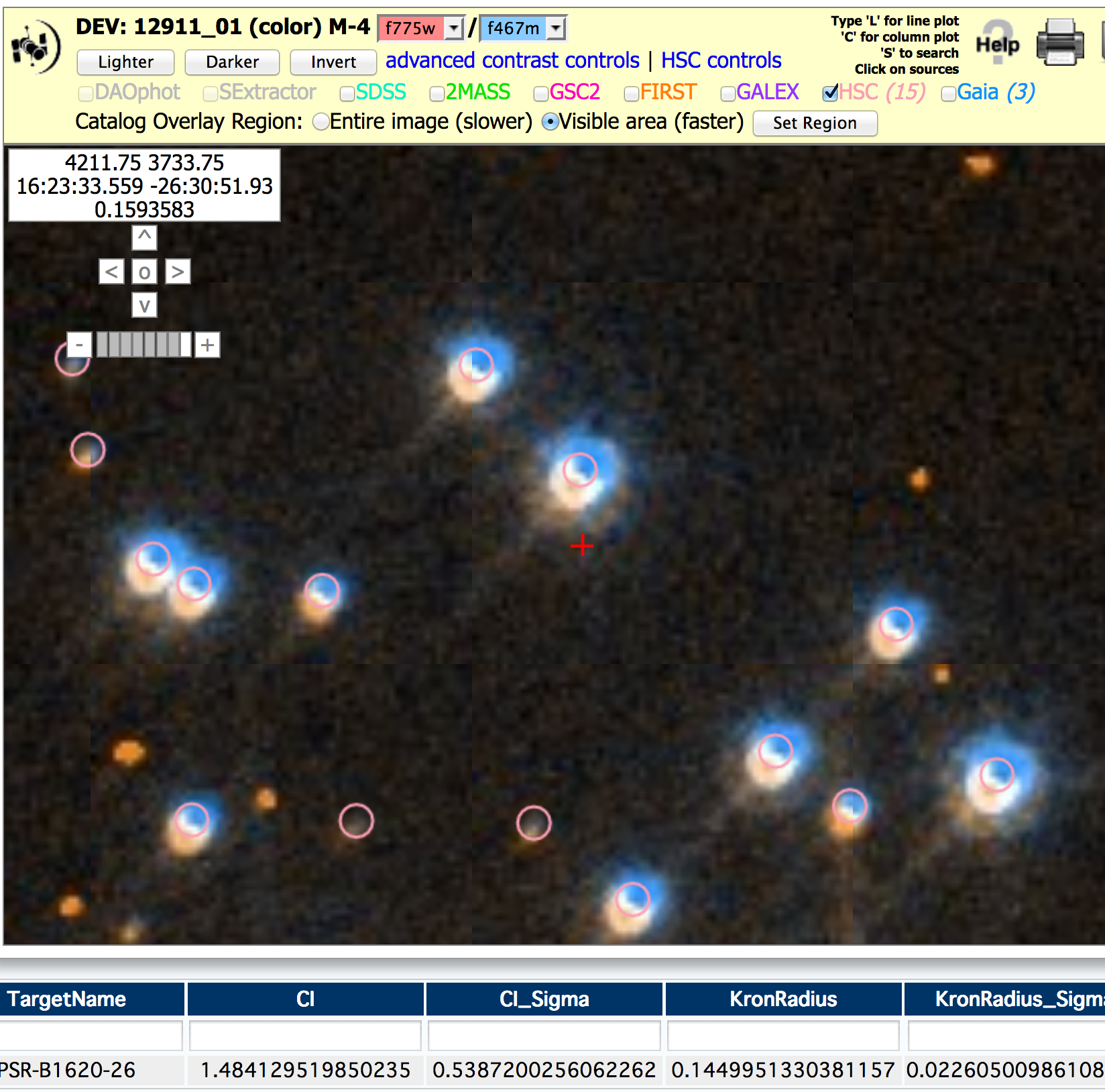 When combining images, the HLA assumes that exposures within a visit
are well aligned. This is generally a good assumption, but
occasionally is not true, especially when combining the observations
from one filter with another. This can result in "smeared" images, bad
photometry (because a position between the offset sources is
measured), and an abnormal Concentration Index.
When combining images, the HLA assumes that exposures within a visit
are well aligned. This is generally a good assumption, but
occasionally is not true, especially when combining the observations
from one filter with another. This can result in "smeared" images, bad
photometry (because a position between the offset sources is
measured), and an abnormal Concentration Index.
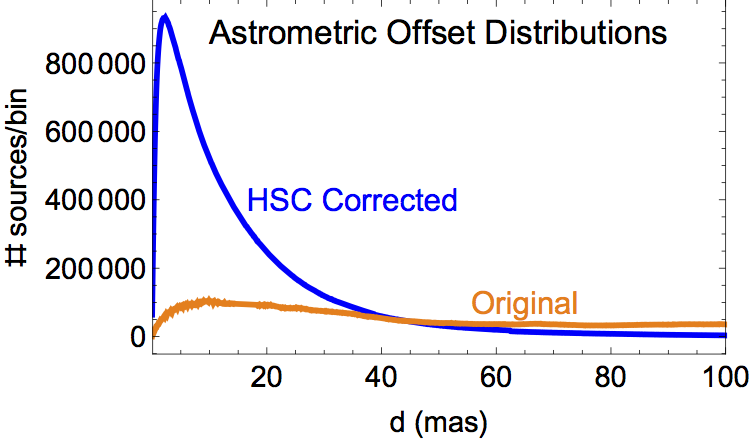
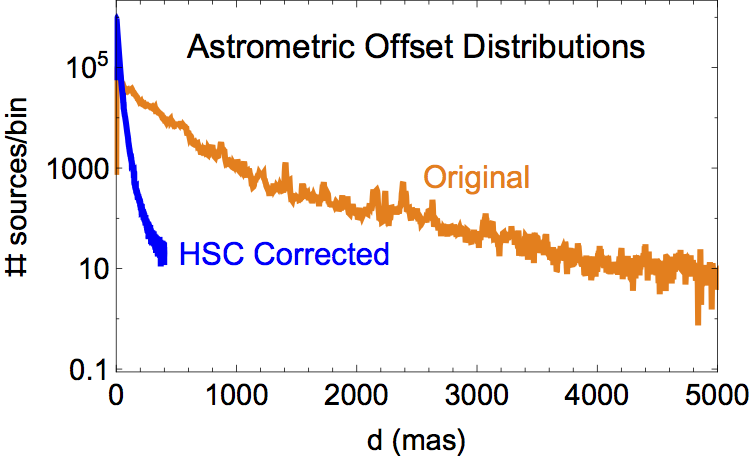
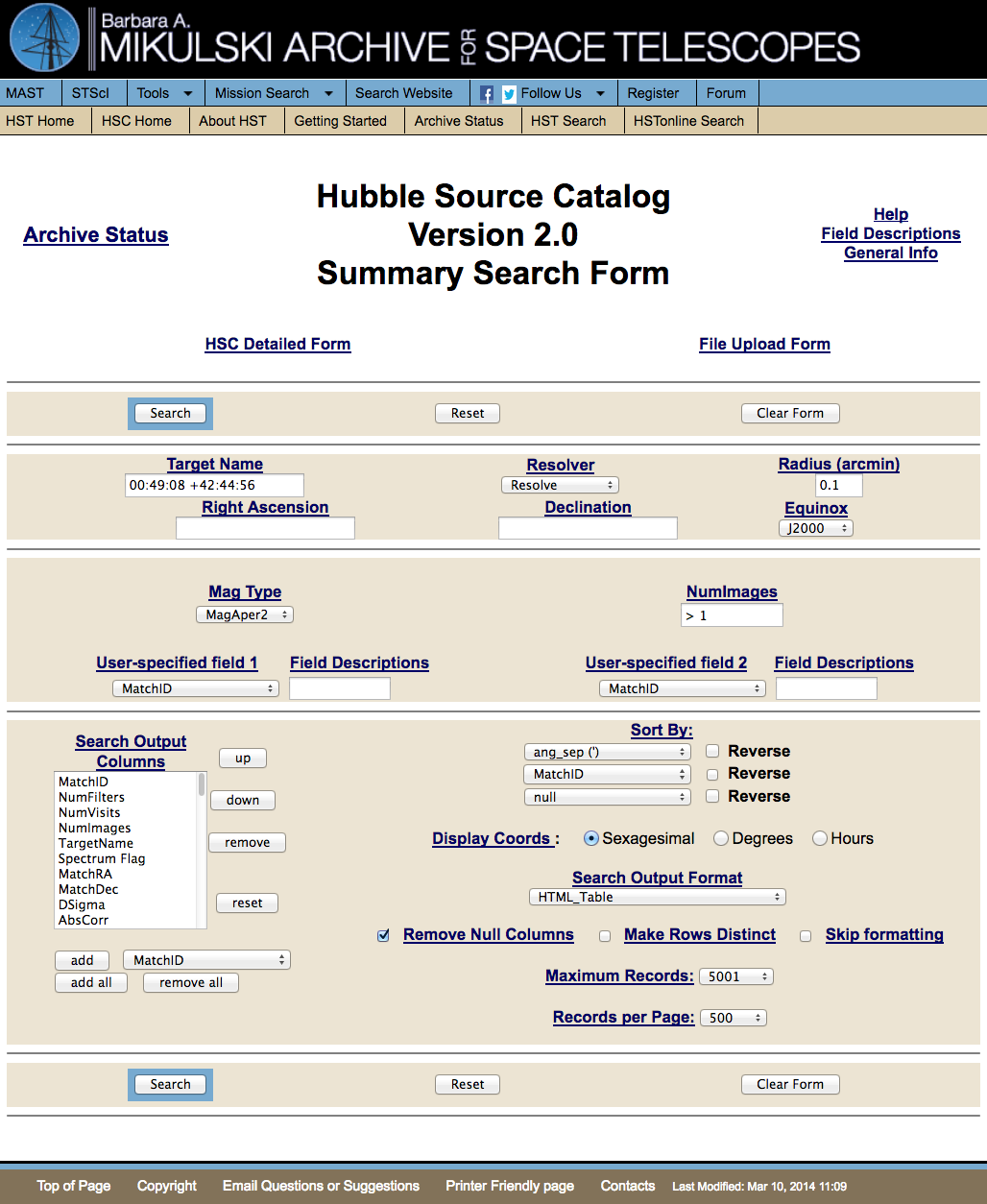


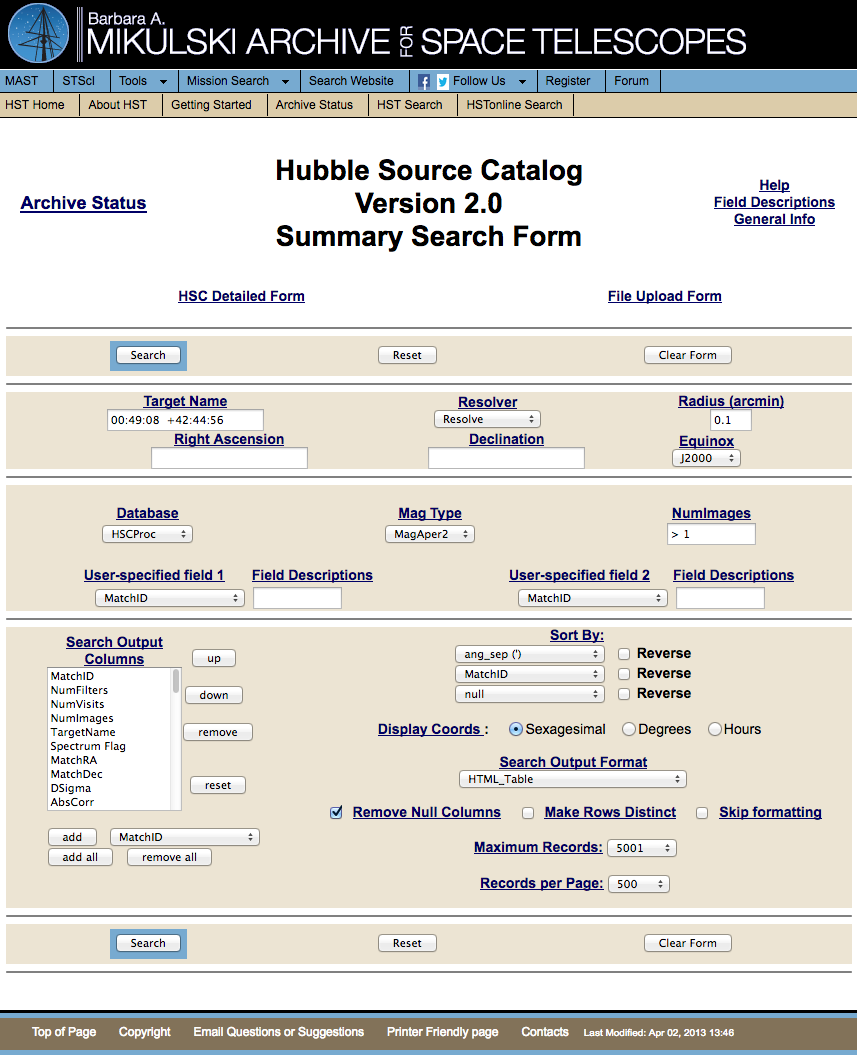
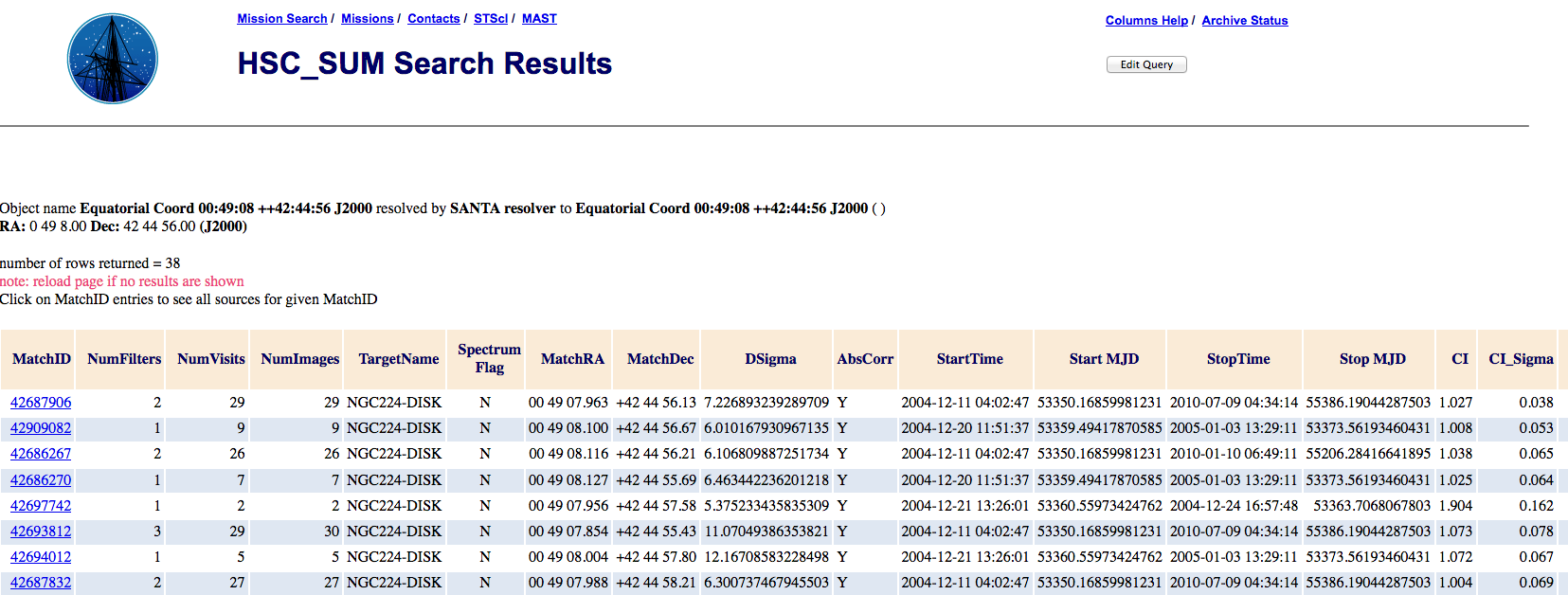


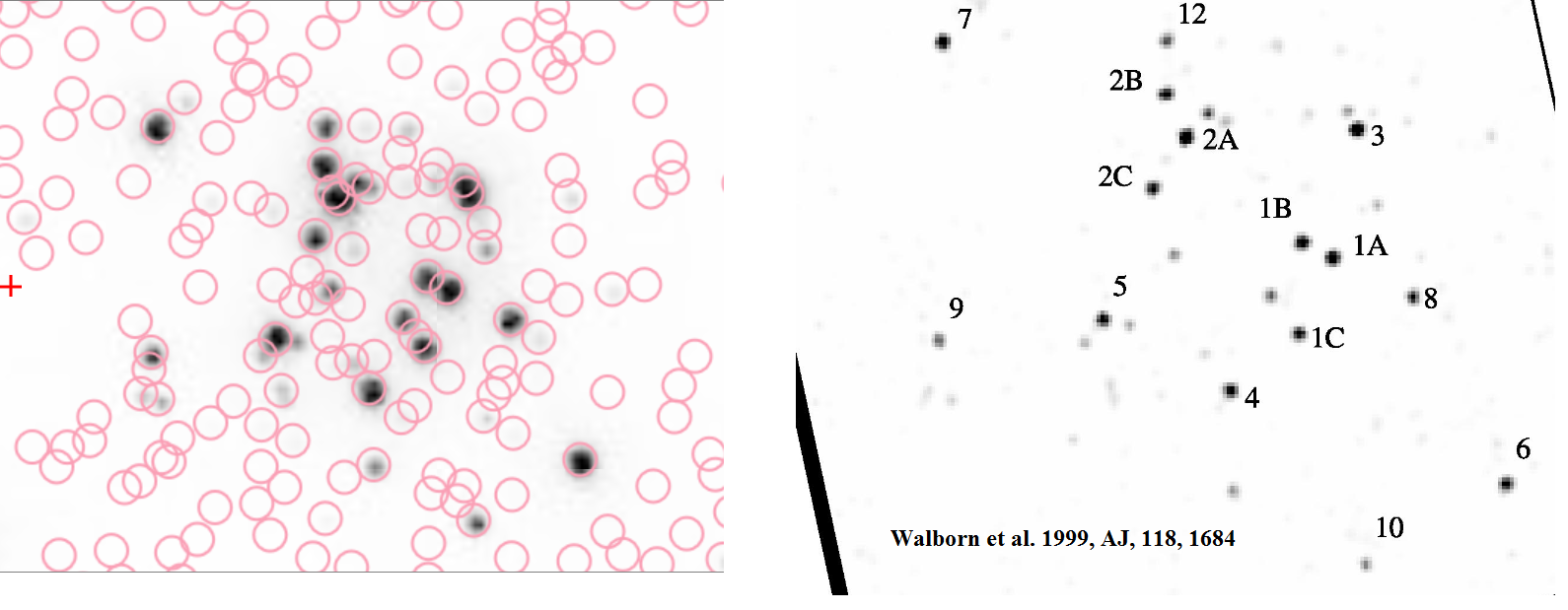 For example, this figure shows how
For example, this figure shows how
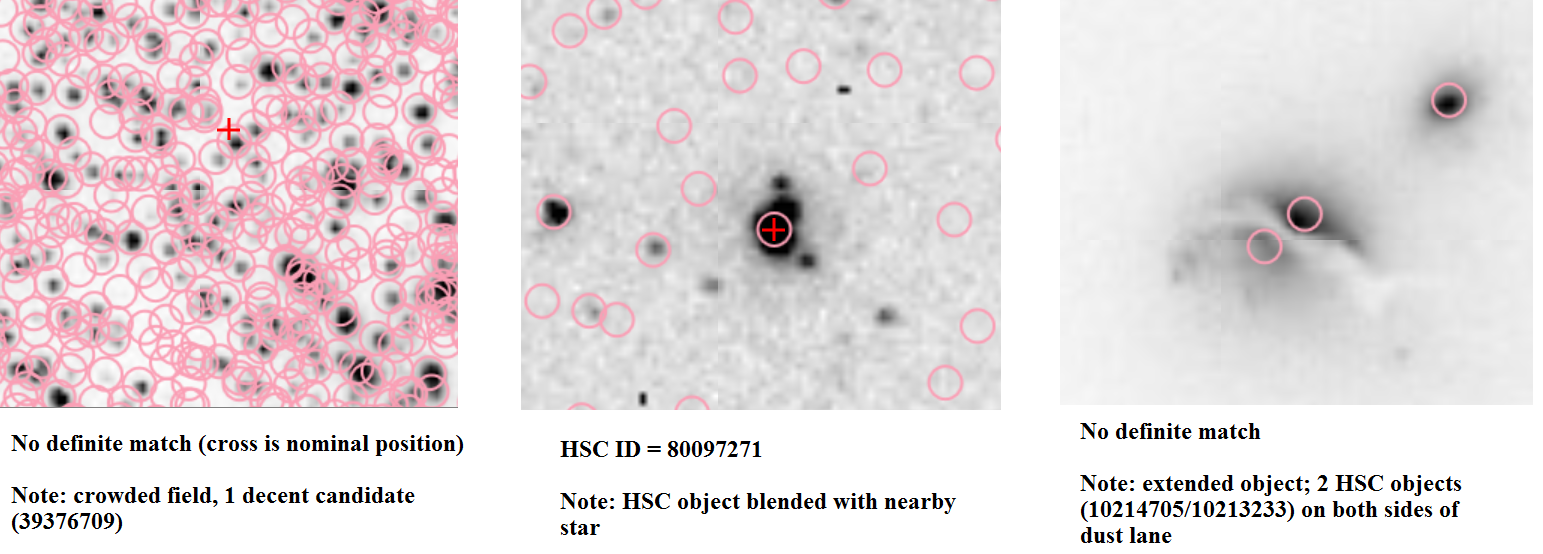 When doing the manual matching, sometimes there were issues with
the imaging data (e.g. crowded field, extended object) that
could impact the quality of the match between the HSC and the spectral data.
This information is included in the notes, as shown in these three examples.
When doing the manual matching, sometimes there were issues with
the imaging data (e.g. crowded field, extended object) that
could impact the quality of the match between the HSC and the spectral data.
This information is included in the notes, as shown in these three examples.
 Here is an example of a match used in Use Case #8 (i.e., HSC MatchID=29157274)
Here is an example of a match used in Use Case #8 (i.e., HSC MatchID=29157274)
 icon in the MAST Discovery Portal you will
get the HSC photometric summary page for the object. See
icon in the MAST Discovery Portal you will
get the HSC photometric summary page for the object. See 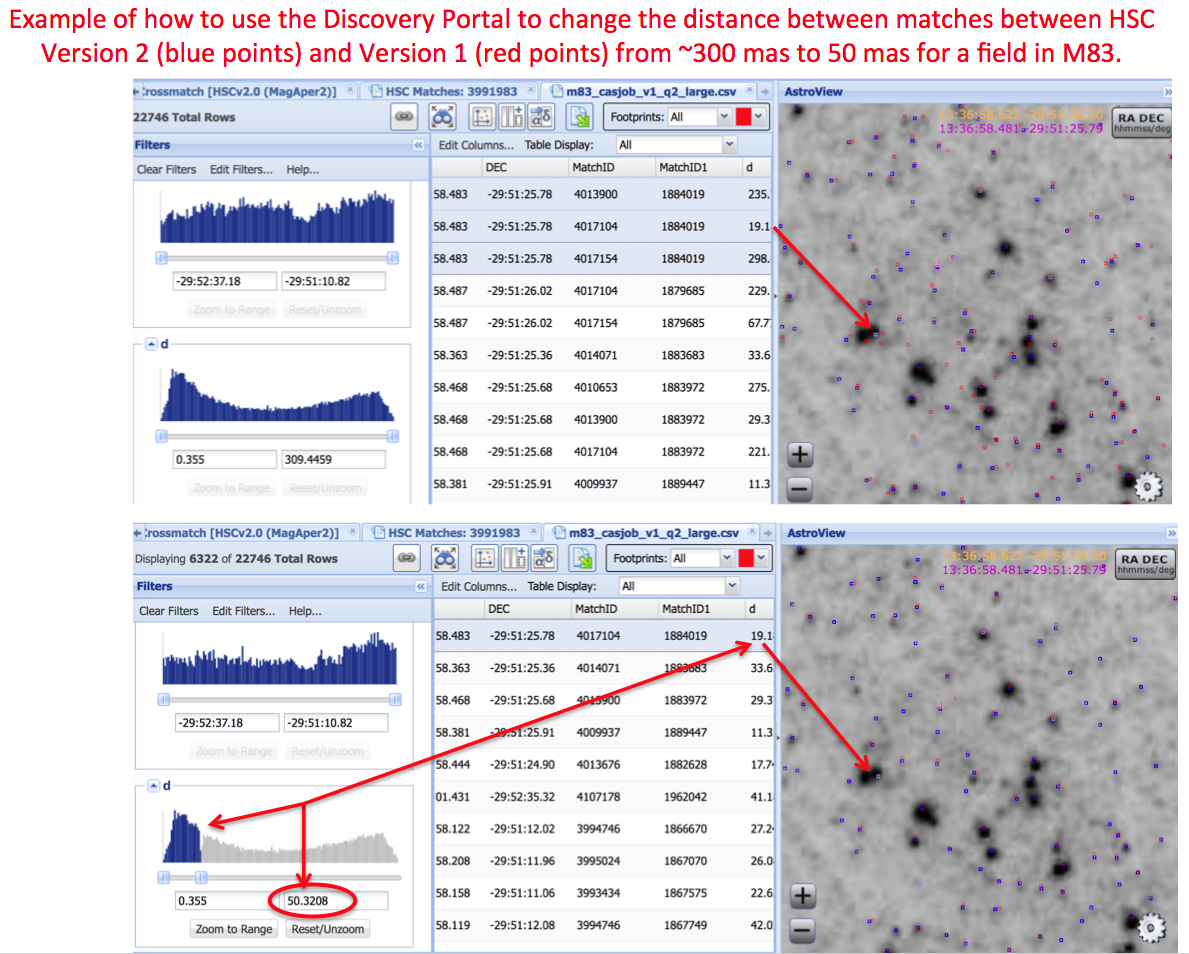 Note that this script assumes:
Note that this script assumes:  icon).
icon).
 icon you mention in the use case? I don't see it on the screen.
icon you mention in the use case? I don't see it on the screen.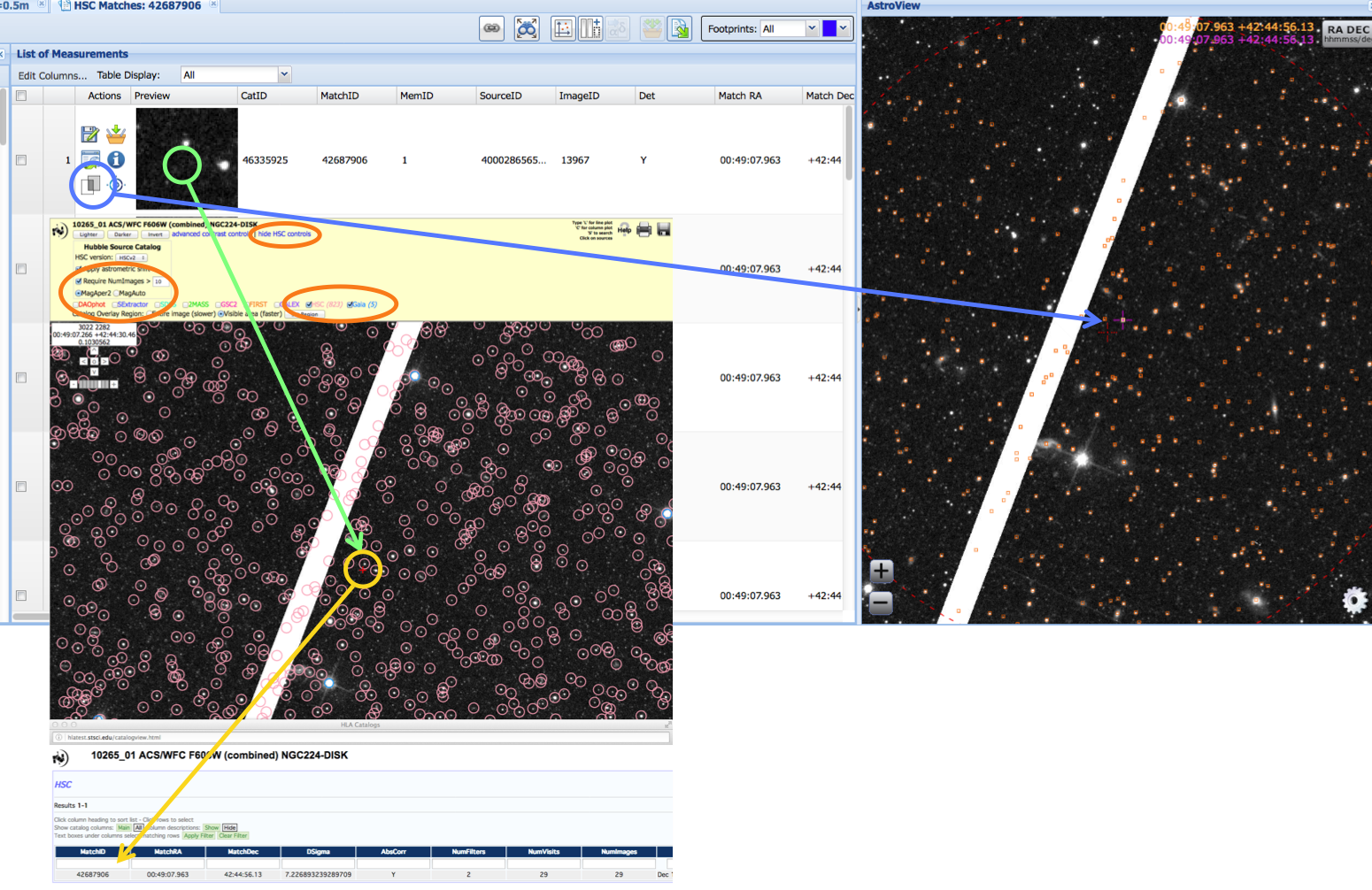
 icon under
Actions (Load Detailed Results)
. This will show you the
details for a particular MatchID, including cutouts for all the HST
images that went into this match. If you then click on the
icon under
Actions (Load Detailed Results)
. This will show you the
details for a particular MatchID, including cutouts for all the HST
images that went into this match. If you then click on the  icon under Action (Toggle Overlay Image) (
icon under Action (Toggle Overlay Image) ( icon for the target of interest.
icon for the target of interest.
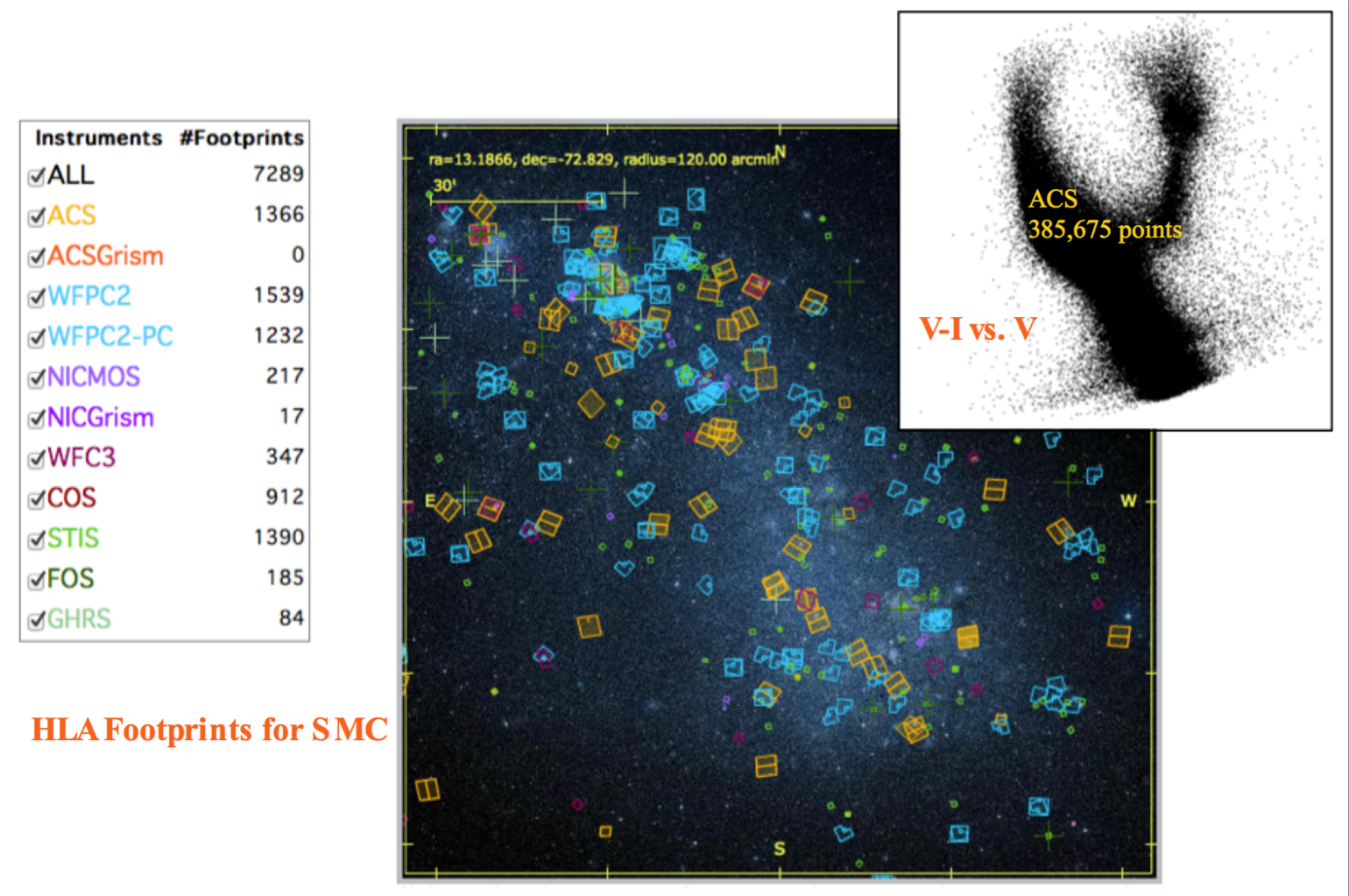 While HSC CasJobs does not
have the limitations of only including a
small subsample of the HSC (i.e., 50,000 objects), as is the
case for the MAST Discovery Portal, it
also does not have the wide variety of
graphic tools available in the Discovery
Portal. Hence the two systems are
complementary.
While HSC CasJobs does not
have the limitations of only including a
small subsample of the HSC (i.e., 50,000 objects), as is the
case for the MAST Discovery Portal, it
also does not have the wide variety of
graphic tools available in the Discovery
Portal. Hence the two systems are
complementary. 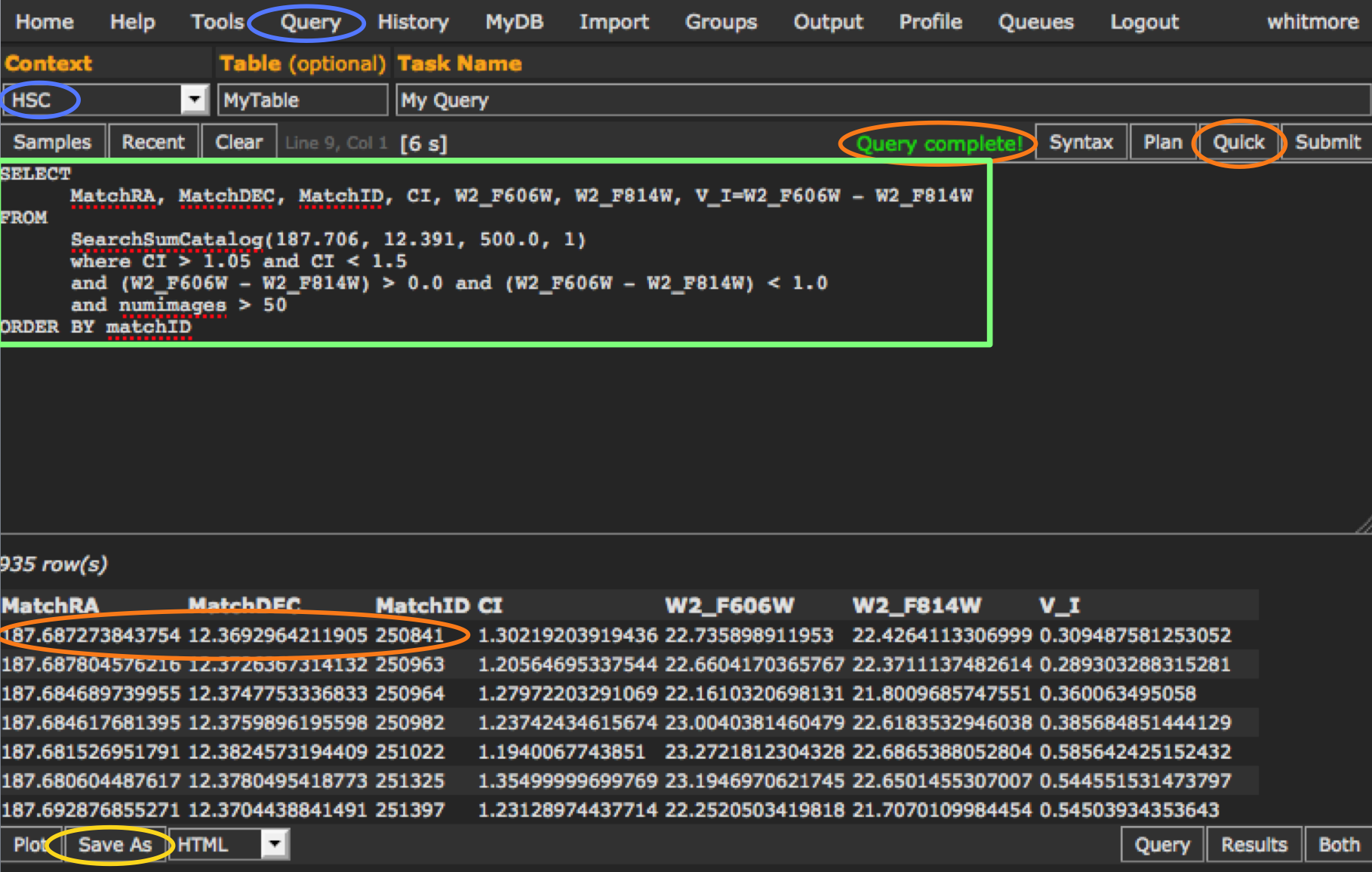







 In this figure we compare photometry
from version 2 and version 1 in
a field in M31. This figure was made by requiring
the same individual measurements are present in
both versions, so that we are comparing "apples with apples". We find that the agreement is very
good, with typical uncertainties of a few hundreds of a magnitude.
Similar comparisons (e.g., in M87 where most
of the point-like sources are actually resolved
globular clusters) show similar results.
In this figure we compare photometry
from version 2 and version 1 in
a field in M31. This figure was made by requiring
the same individual measurements are present in
both versions, so that we are comparing "apples with apples". We find that the agreement is very
good, with typical uncertainties of a few hundreds of a magnitude.
Similar comparisons (e.g., in M87 where most
of the point-like sources are actually resolved
globular clusters) show similar results.



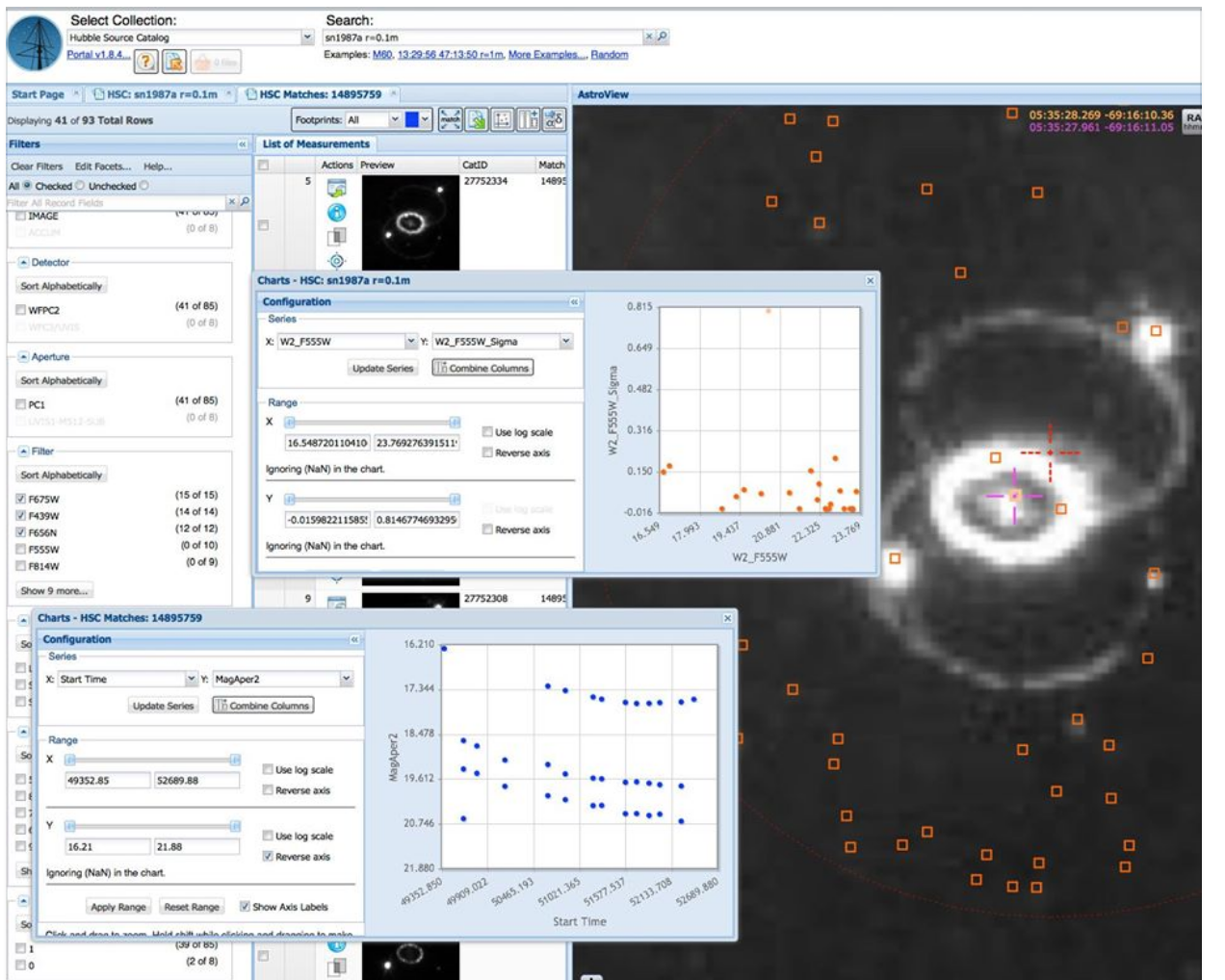 Yes.
Yes.